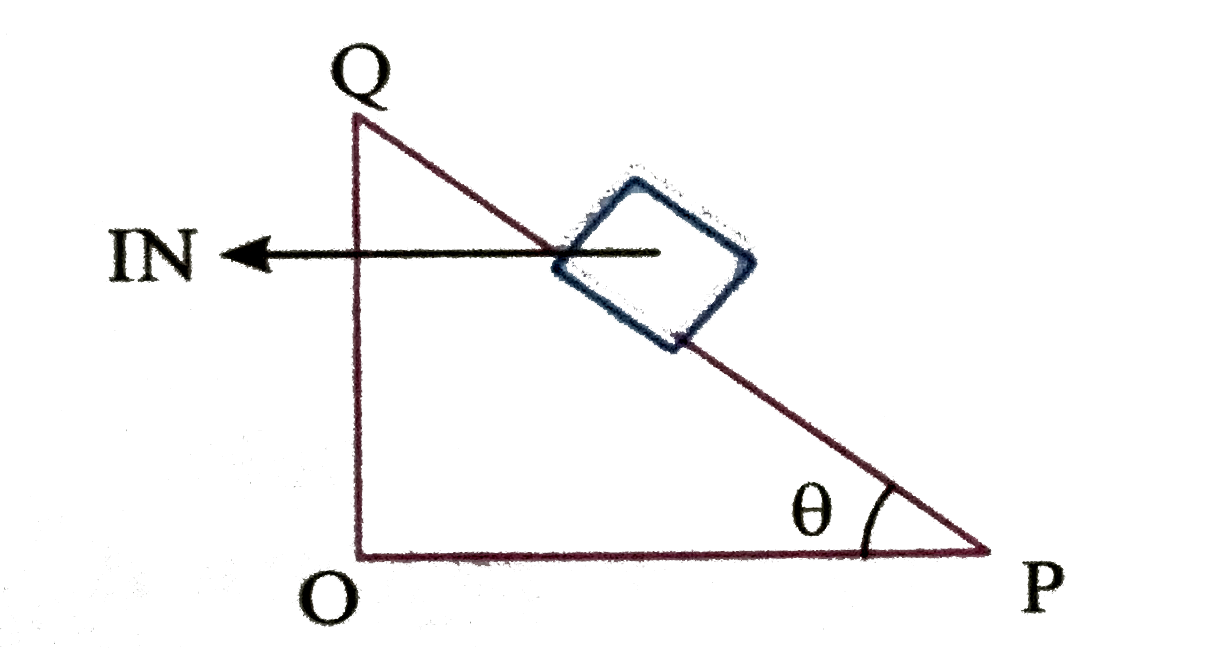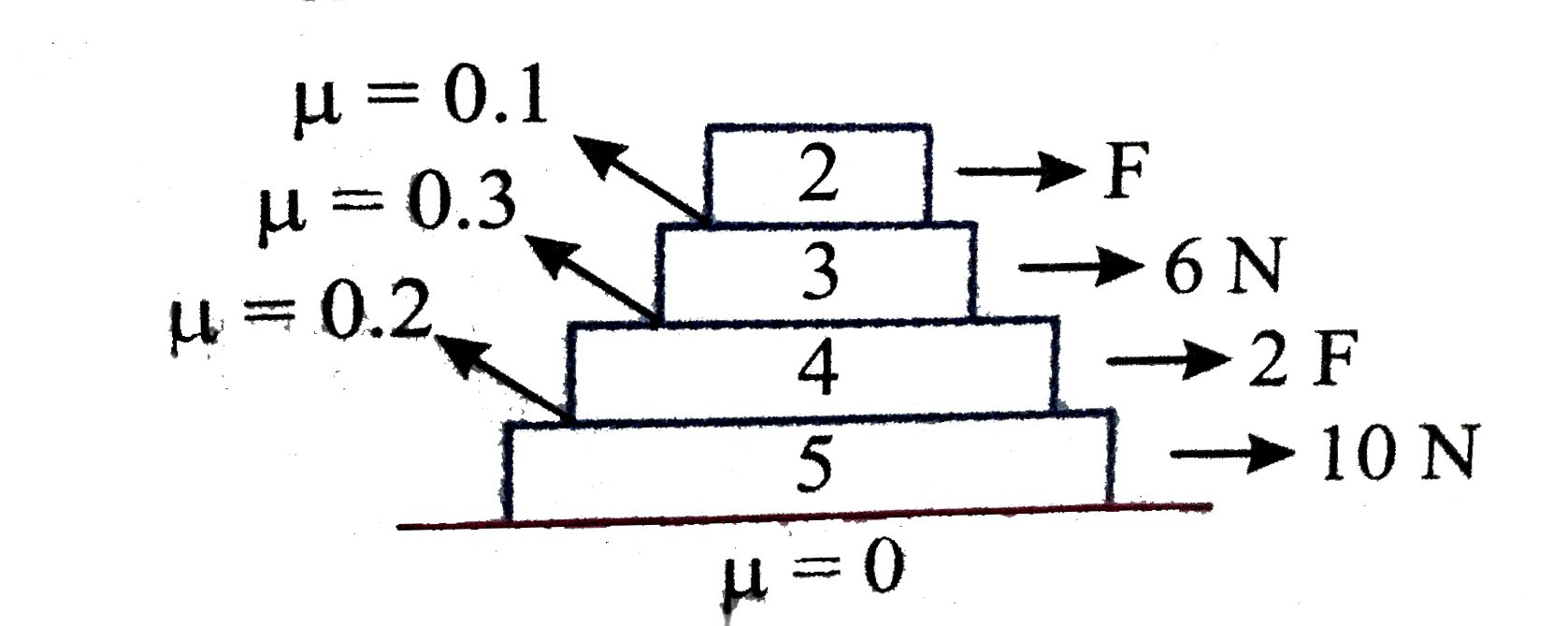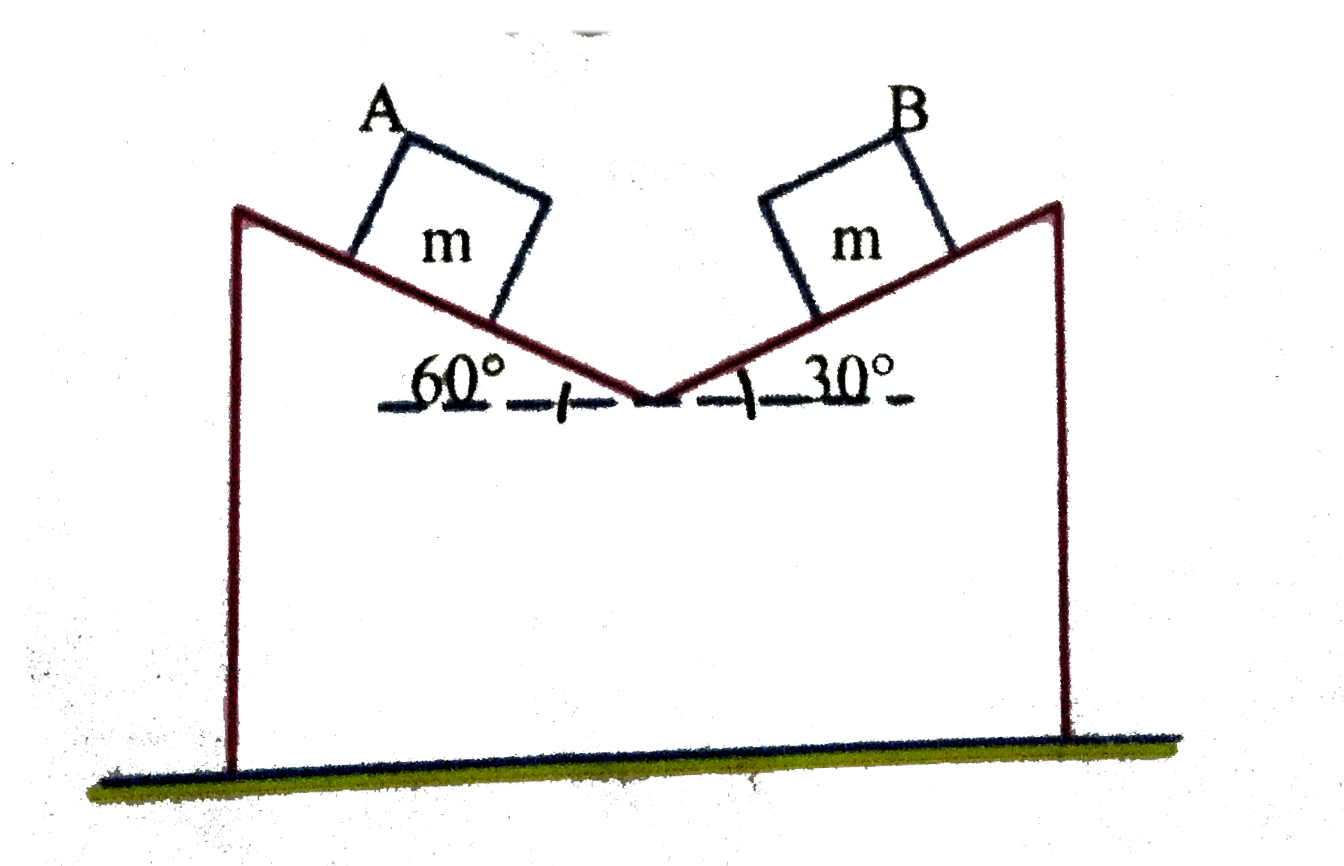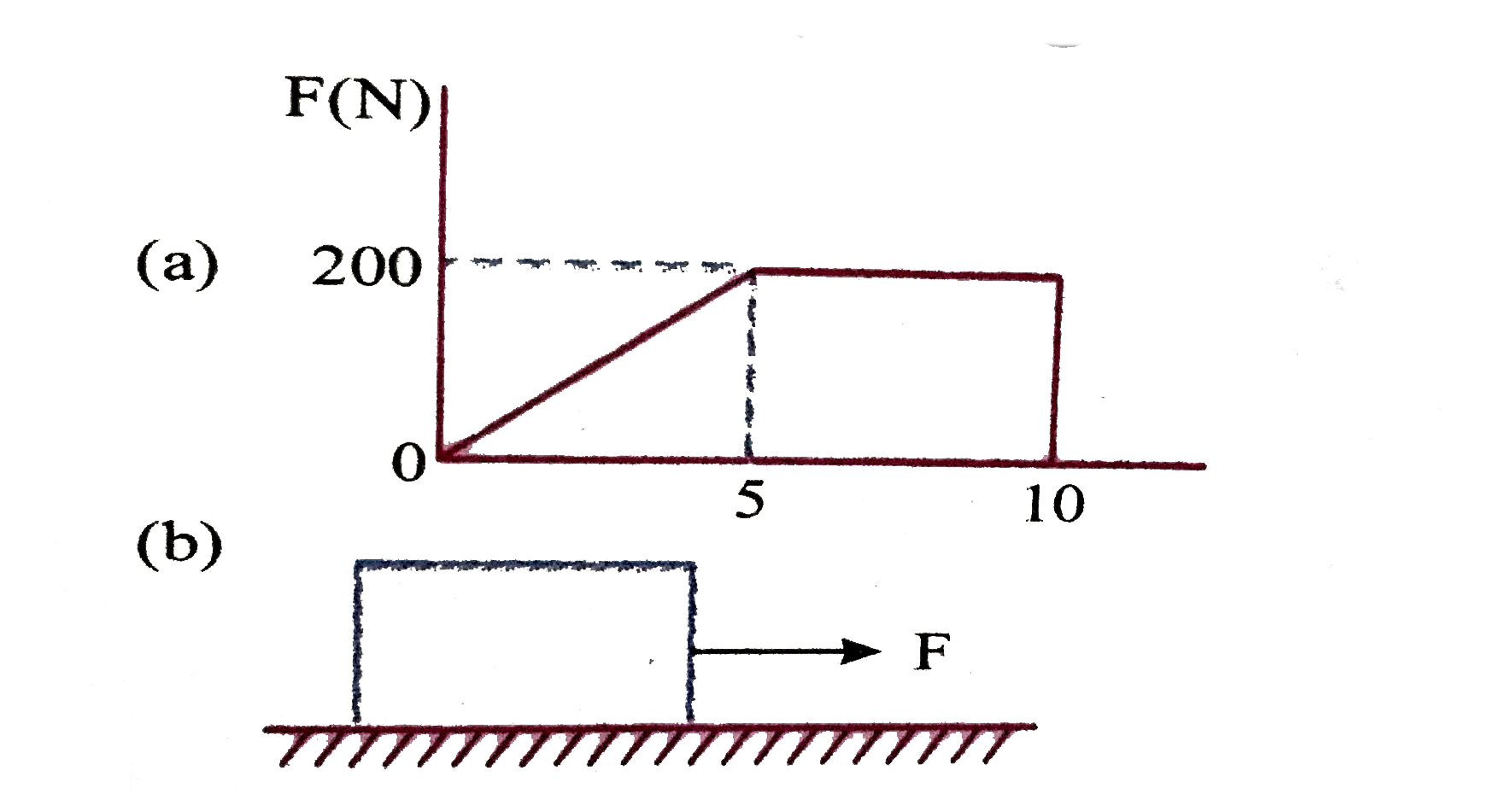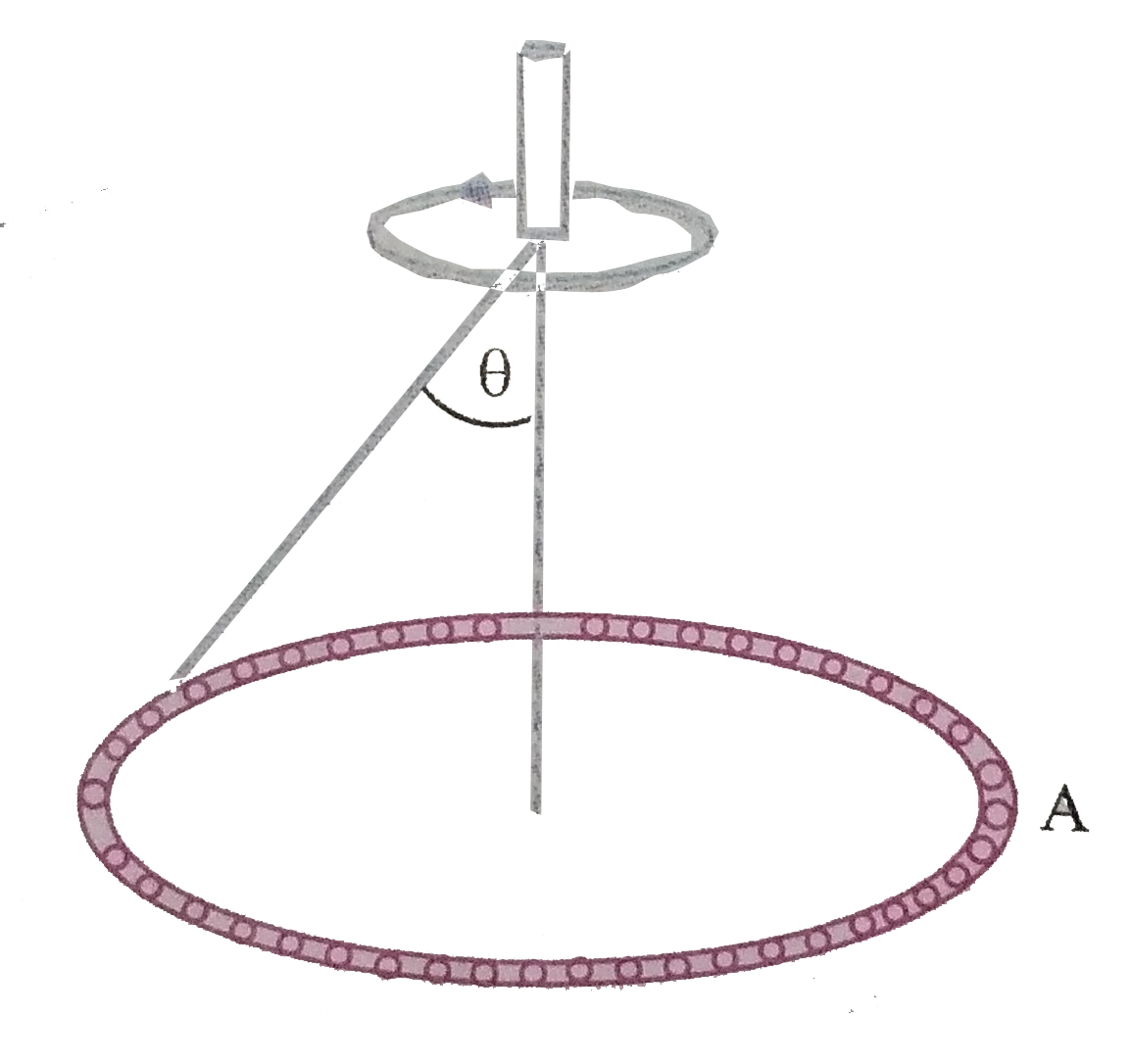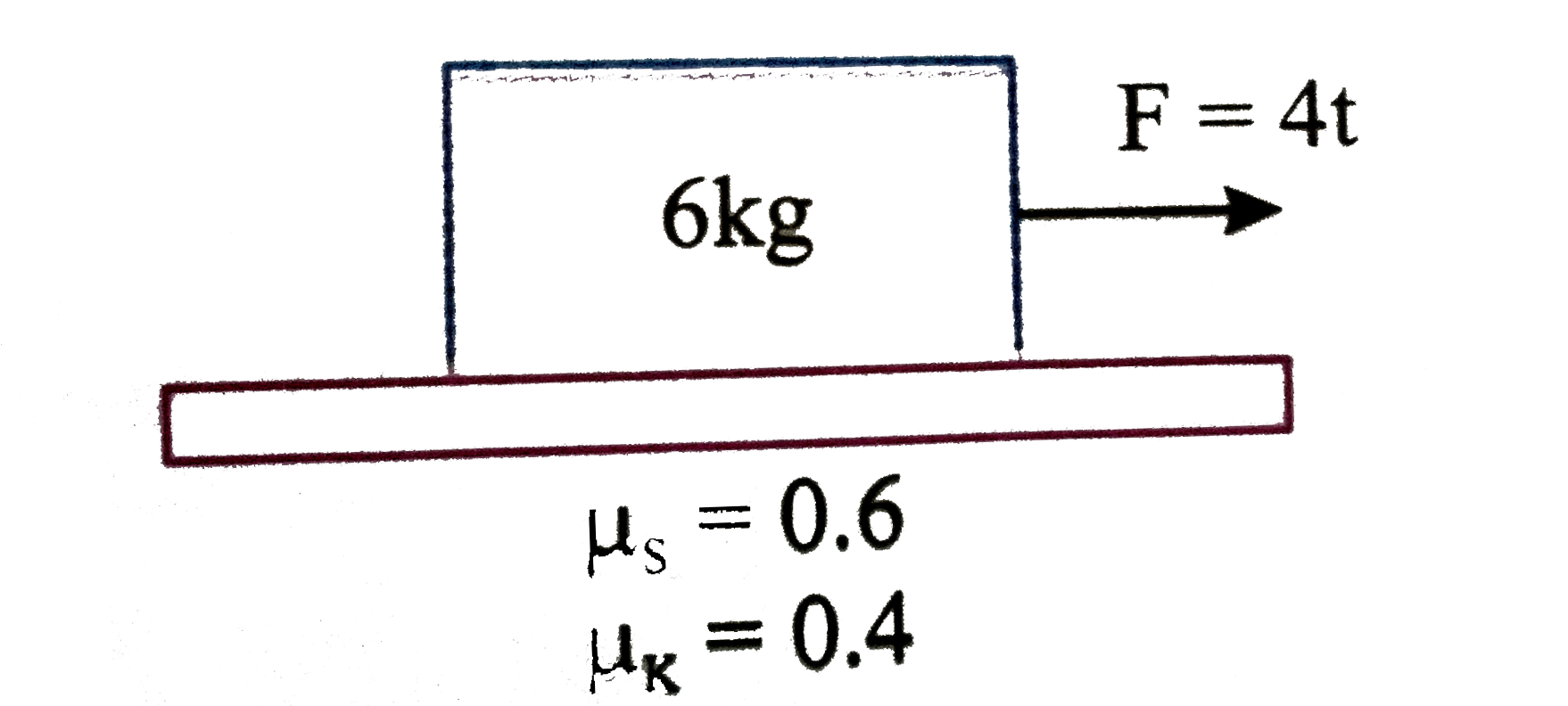Matrix - Match from GR BATHLA & SONS PHYSICS (HINGLISH) FRICTION AND CIRCULAR MOTION for Class 11
| Class 11 | PHYSICS |
| Chapter | FRICTION AND CIRCULAR MOTION |
| GR BATHLA & SONS PHYSICS (HINGLISH) | Matrix - Match |
| Medium | English |
| Academic Year | 2023-2024 |
Question 1
In the diagram shown, the blocks A, B and C weight, 3kg, 4kg and 5kg respectively. The coefficient of sliding friction between any two surface is 0.25. A is held at rest by a massless rigid rod fixed to the wall while B and C are connected by a light flexible cord passing around a frictionless pulley. Find the force F necessary to drag C along the horizontal surface to the left at constant speed. Assume that the arrangement shown in the diagram, B on C and A on B, is maintained all through. (g=9.8m/s2)
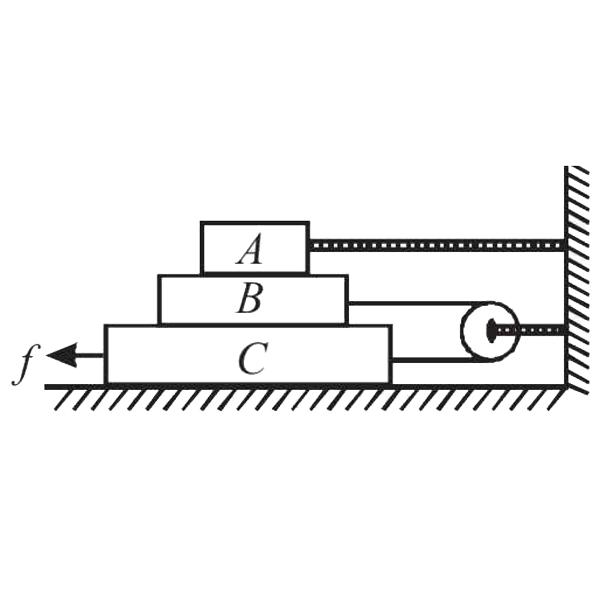 View Solution
View SolutionQuestion 2
A 40 kg slab rests on a frictionless floor . A 10 kg block rests on the top of the slab . [Fig. 7.81 (a)] . The coefficients of static and dynamic friction are 0.60 and 0.40 respectively . The 10 kg block is pulled by a horizontal force of 100 N . what are the resulting accelerations of (a) the block (b) the slab ? ( g = 10m/s2)
 View Solution
View SolutionQuestion 3
A body of mass M with a small block m placed on it rests on a smooth horizontal surface. The block is set in motion in the horizontal direction with a velocity v. To what height relative to the initial level will the block rise after breaking off from the body M. Friction can be assumed to be absent.
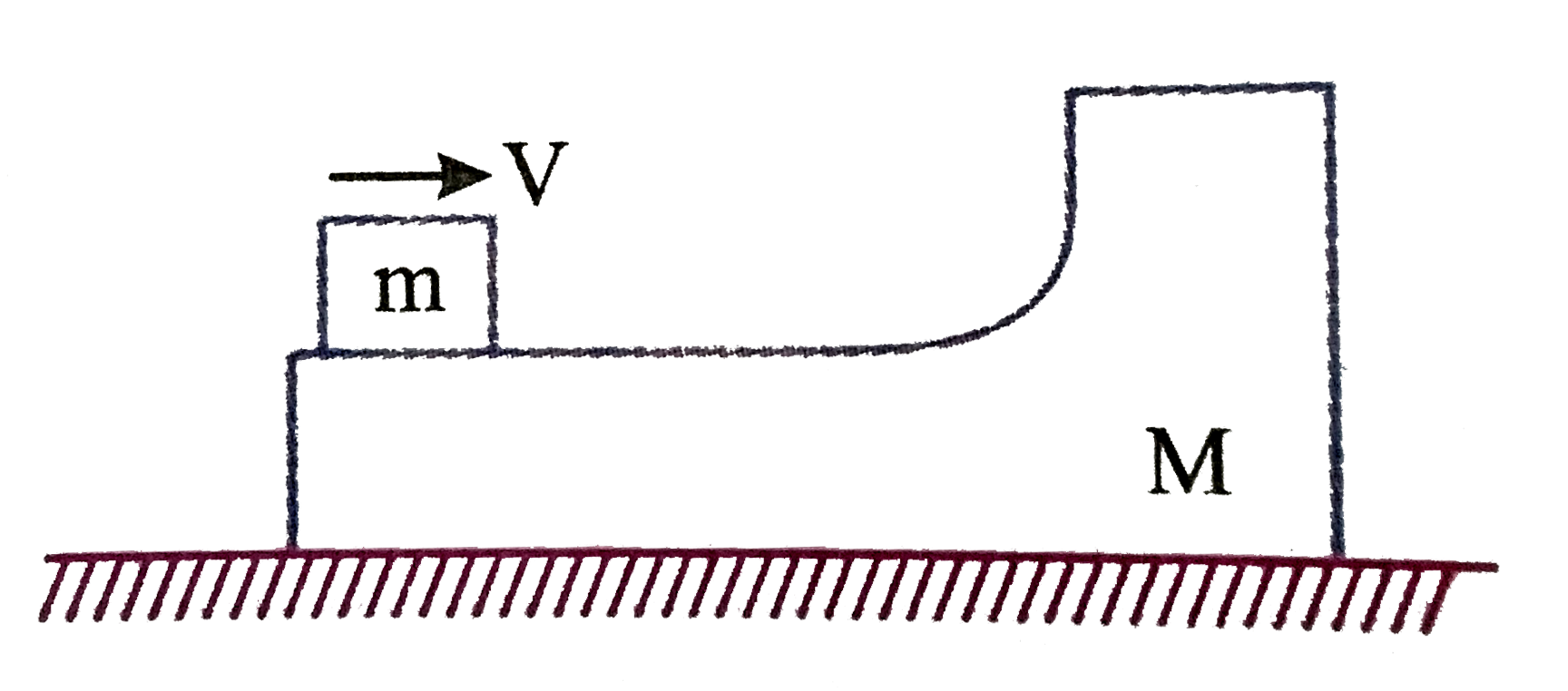 View Solution
View SolutionQuestion 4
A rock-climber (49 kg) is managing to be at rest between two vertical rocks pressing one rock A by his feet and the other B by his back . If the coefficient of friction between his shoes and wall is A 1.2 while between his back and wall B is 0.8 and limiting friction acts at all the contacts , then : (a) What is his push against the rock ? (b) What percent of the weight is supported by the frictional force an legs ?
 View Solution
View SolutionQuestion 5
The three flat blocks in the figure are positioned on the 30∘ incline and a force parallel to the inclined plane is applied to the middle block . The upper block is prevented from moving by a wire which attaches it to the fixed support . The coefficient of static friction for each of the three pairs of contact surfaces is shwon in the figure . Determine the maximum value which P may have before any slipping takes place .
 View Solution
View SolutionQuestion 7
A 10kg block rests on a 5kg bracket as shown in figureThe 5kg breaket rests on a horizontal surface The coefficient of frictionbetween the 10kg block and the braket on wich it rests are μs=0.40andμk=0.30
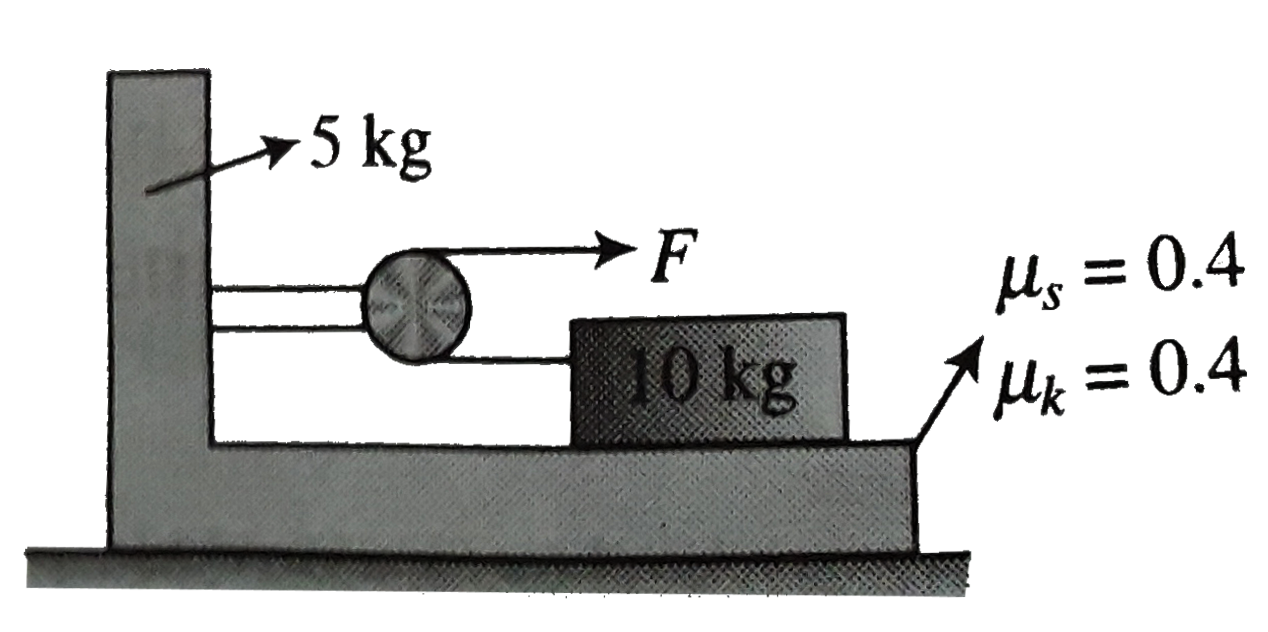
If the 10kg block is not to slide on the braket , the corresponding acceleration of the 5kg braacket is View SolutionQuestion 8
A block of mass 0.5 kg rests on a wedge of mass 2 kg as in Fig. 7.87 . The wedge is acted on by a horizontal force F and slides on a frictionless surface . If the coefficient of static friction between the wedge and the block is μs=0.8 , and the angle of inclination is 30∘ , find the maximum and minimum values of F for which the block does not slip . Take (g = 10m/s2)
 View Solution
View SolutionQuestion 10
In the Fig 7.89 shown , m2=2.5 kg , h = 1.5 m , the system is released from rest at t = 0 and the mass m2 strikes ground at t = 0.82s . The system is placed in its initial position and a 1.2 kg mass is placed on top of the block of mass m1 . Released from rest , the mass m2 now strikes the ground 1.3 s later . Determine the mass m1 and the coefficient of kinetic friction between m1 and the shelf .
 View Solution
View SolutionQuestion 11
Figure-2.85 shows a block B of mass m, cart C of mass M, and the coefficient of static between the block and the cart is μ. Neglect frictional between wheels and axles and the rotational effects of the wheels. Determine the minimum value of F which must be applied on B such that it will not slide.

[mgμ(1+mM)]View SolutionQuestion 12
A block of mass 2.20 kg is accelerated across a rough surface by a rope passing over a pulley as shown in Fig. 7.91 . The tension in the rope is 10.0 N , and the pulley is 10.0 cm above the block . The coefficient of friction is 0.4 .
(a) Determine the acceleration of block when x = 0.4 m .
(b) Find the value of x at which the acceleration becomes zero .
 View Solution
View SolutionQuestion 13
A circular disc with a groove along its diameter is placed horizontally . A block of mass 1 kg is placed as shown . The coefficient of friction between the block and all surfaces of groove in contact is μ=2/5 . The disc has an acceleration of 25m/s2 . find the acceleration of the block with respect to disc .
 View Solution
View SolutionQuestion 14
A block rests on a rough inclined plane as shown in Fig. 7.93 . A horizontal force is applied to it . (a) Find out the force of reaction .
(b) Can the force of friction be zero ? If yes , when ? (c) Assuming that , friction is not zero , find it magnitude and the direction of its limiting value .
 View Solution
View SolutionQuestion 16
A thin uniform copper rod of length l and mass m rotates uniformly with an angular velocity ω in a horizontal plane about a vertical axis passing through one of its ends. Determine the tension in the rod as a function of the distance r from the rotation axis. Find the elongation of the rod. View SolutionQuestion 17
A smooth semicircular wire-track of radius R is fixed in a vertical plane. One end of a massless spring of natural length 3R/4 is attached to the lowest point O of the wire-track. A small ring of mass m, which can slide on the track, is attached to the other end of the spring. The ring is held staionary at point P such that the spring makes an angle of 60∘ with the vertical. The spring constant K=mg/R. Consider the instant when the ring is released, and (i) draw the free body diagram of the ring, (ii) determine the tangential acceleration of the ring and the normal reaction.
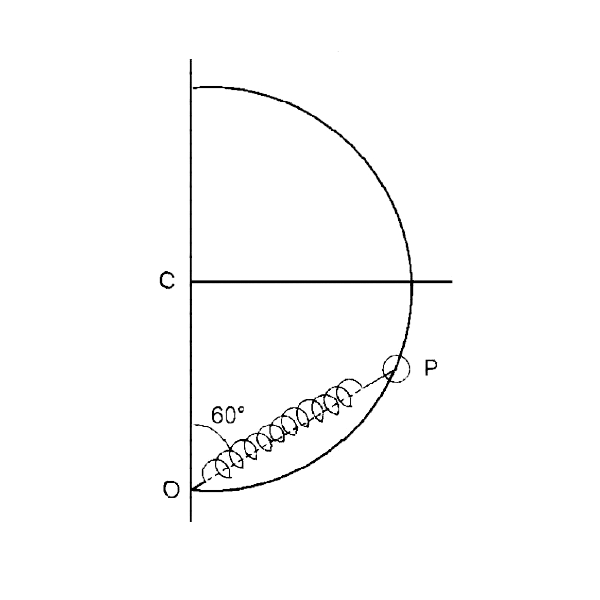 View Solution
View SolutionQuestion 18
A circular table with smooth horizontal surface is rotating at an angular speed ω about its axis. A groove is made on the surface along a radius and a small particle is gently placed inside the groove at a distance l from the centre. Find the speed of the particle with respect to the table as its distance from the centre becomes L.View SolutionQuestion 21
Two blocks of mass m1=10kg and m2=5kg connected to each other by a massless inextensible string of length 0.3m are placed along a diameter of the turntable. The coefficient of friction between the table and m1 is 0.5 while there is no friction between m2 and the table. the table is rotating with an angular velocity of 10rad/s. about a vertical axis passing through its center O. the masses are placed along the diameter of the table on either side of the center O such that the mass m1 is at a distance of 0.124m from O. the masses are observed to be at a rest with respect to an observed on the tuntable (g=9.8m/s2).
(a) Calculate the friction on m1
(b) What should be the minimum angular speed of the turntable so that the masses will slip from this position?
(c ) How should the masses be placed with the string remaining taut so that there is no friction on m1.View SolutionQuestion 29
A block A of mass 2 kg rests on another block B of mass 8 kg which rests on a horizontal floor. The coefficient of friction between A and B is 0.2 while that between B and floor is 0.5. when a horizontal force of 25 N is applied on the block B. the force of friction between A and B is View SolutionQuestion 30
A 40 kg slab rests on a frictionless floor . A 10 kg block rests on top of the slab (Fig . 7. 121). The static coefficient of friction between the block and the slab is 0.60 while the kinetic coefficient is 0.40 . The 10 kg block is acted upon by a horizontal force of 100 N . if g = 9.8m/s2 the resulting acceleration of the slab will be :
 View Solution
View SolutionQuestion 37
A block of mass 2 kg rests on a rough horizontal plank , the coefficient of friction between the plank and block is 0.3. If the plank is pulled horizontally with a constant acceleration of 4m/s2 , the distance moved by the block on the plank in 5 second starting from rest (in m) is : (Take g = 10m/s2)View SolutionQuestion 38
A block released from rest from the top of a smooth inclined plane of inclination 45∘takes time 't' to reach the bottom . The same block released from rest , from top of a rough inclined plane of same inclination , takes time '2t' to reach the bottom , coefficient of friction is : View SolutionQuestion 44
The rear side of a truck is open and a box of 40 kg mass is placed 5 m from the open end The coefficient of friction between the box and the surface below it is 0.15 On a straight road the truck starts from rest and accelerates with 2m/s2 At what distance from the starting point does the box fall off the truck ? Ignore the size of the box . View SolutionQuestion 48
Wedge is fixed on horizontal surface. Block A is pulled upward by applying a force F as shown in figure and there is no friction between the wedge and the block A while coefficient of friction between A and B is μ. If there is no relative motion between the block A and B then frictional force developed between A and B is
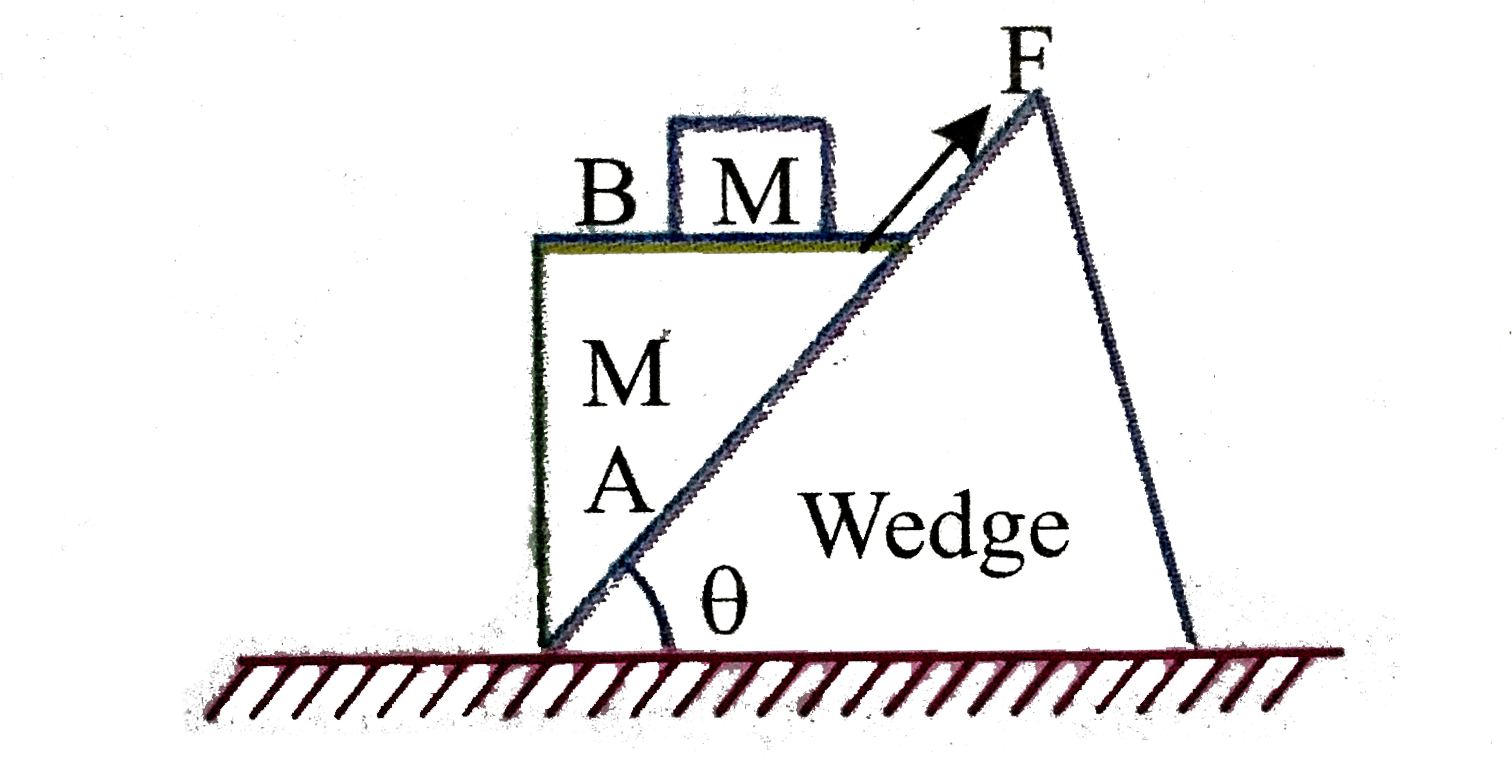 View Solution
View SolutionQuestion 49
Two blocks A&B attached to each other by a mass-less spring, are kept on a rough horizontal surface μ=0.1. A constant force F=200N is applied on blcok B horizon tally as shown below. If a some instant the acceleration of 10kg mass is 12m/s2, then the acceleration of 20kg mass is
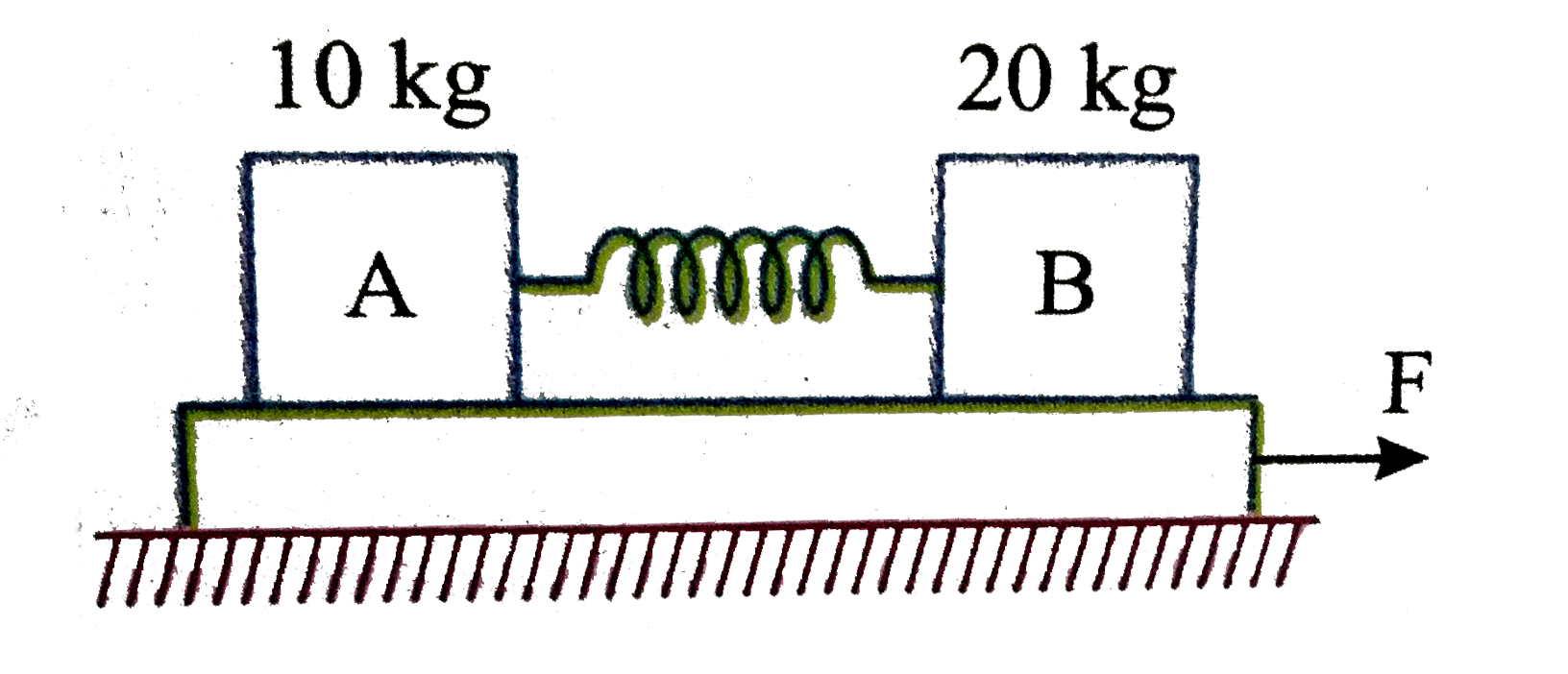 View Solution
View SolutionQuestion 53
A block A is placed over a long rough plank B same mass as shown below. The plank is placed over a smooth horizontal surface. At time t=0, block A is given a velocity v0 in horizontal direction. Let v1 and v2 be the velocity of A & B at time 't'. Then choose the correct graph between v1 or v2 and t.
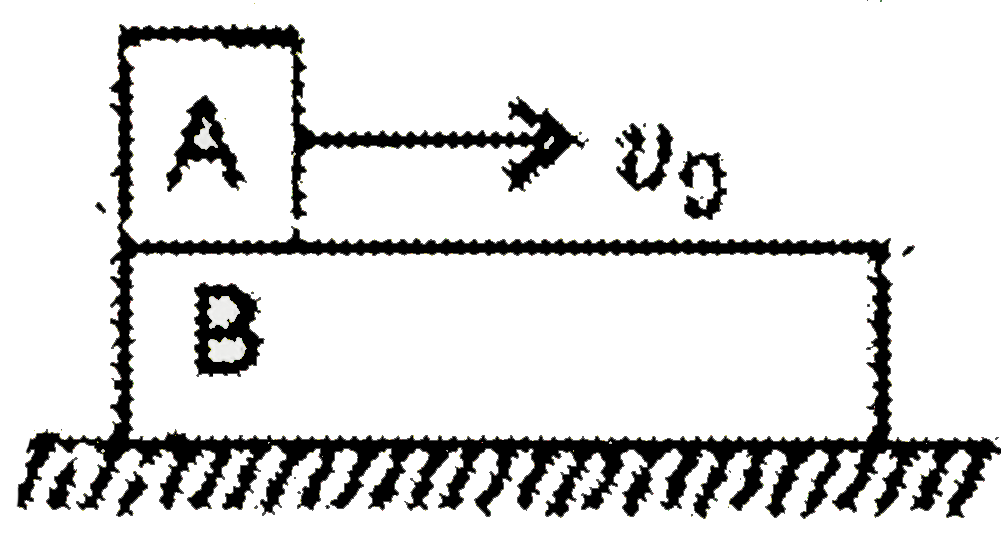 View Solution
View SolutionQuestion 54
A composite inclined plane has three different inclined surfaces AB,BC and CD of heights 1m each and coefficients of friction 1√3,1√8 and 1√15 respectively. A particle given an initial velocity at A along AB transverses the inclined surfaces with uniform speed, reaches D in 5s. The initial speed given is (inm/s)
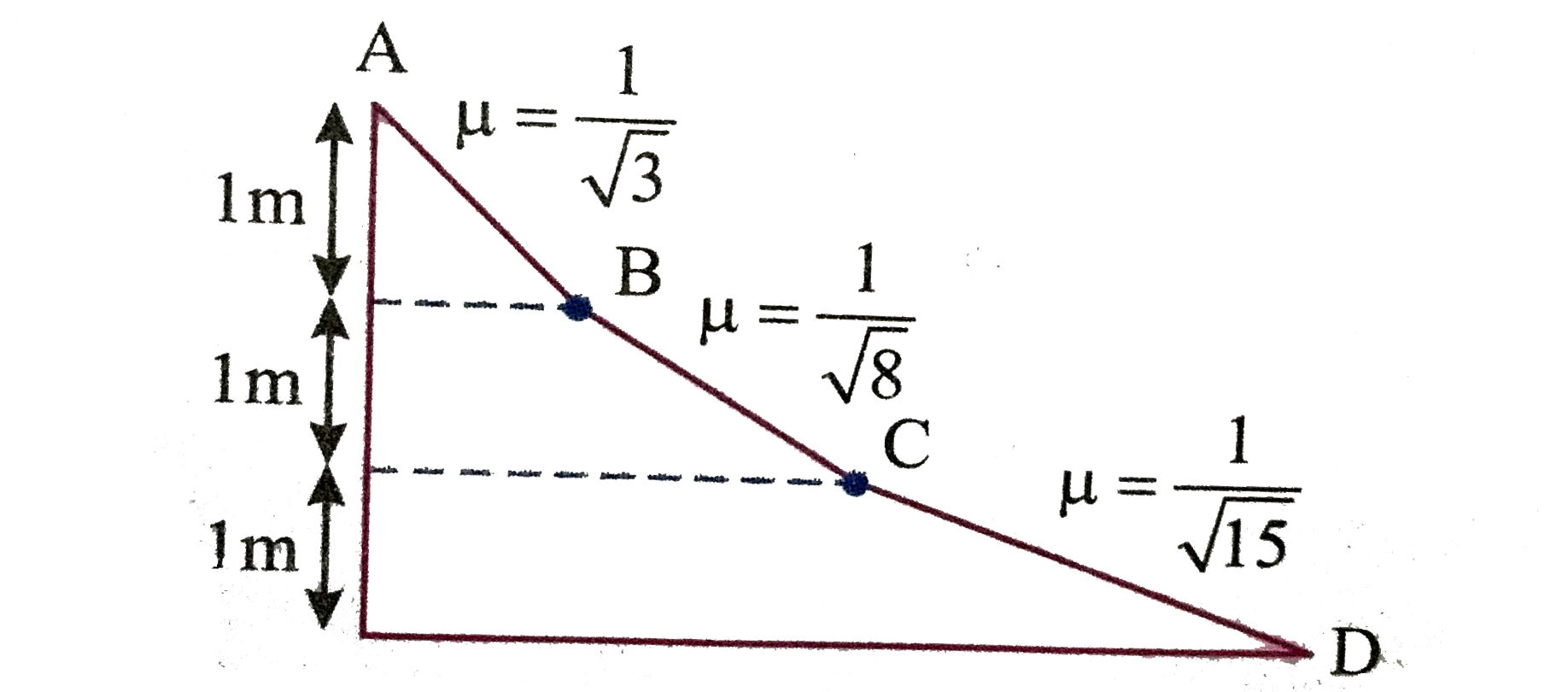 View Solution
View SolutionQuestion 55
A bead of mass m is fitted on to a rod and can move on it without friction. At the initial moment the bead is in the middle of the rod. The rod moves translationally in a horizontal plane with an acceleration a in a direction forming an angle α with the rod. Find the acceleration of the bead relative to the rod.
 View Solution
View SolutionQuestion 58
A small coin of mass 80g is placed on the horizontal surface of a rotating disc. The disc starts from rest and is given a constant angular acceleration α=2rad/s2. The coefficient of static friction between the coin and the disc is μs=3/4 and cofficient of kinetic friction is μk=0.5. The coin is placed at a distance r=1m from the centre of the disc. The magnitude of the resultant force on the coin exerted by the disc just before it starts slipping on the disc is
 View Solution
View SolutionQuestion 60
A particle moves in a circle of radius 4.0 cm clockwise at constant speed of 2ms−1. If ˆx and ˆy are unit acceleration vectors along X-axis and Y-axis respectively (in cms−2), find the acceleration of the particle at the instant half way between P and Q. Refer to Fig.5.14 (a).
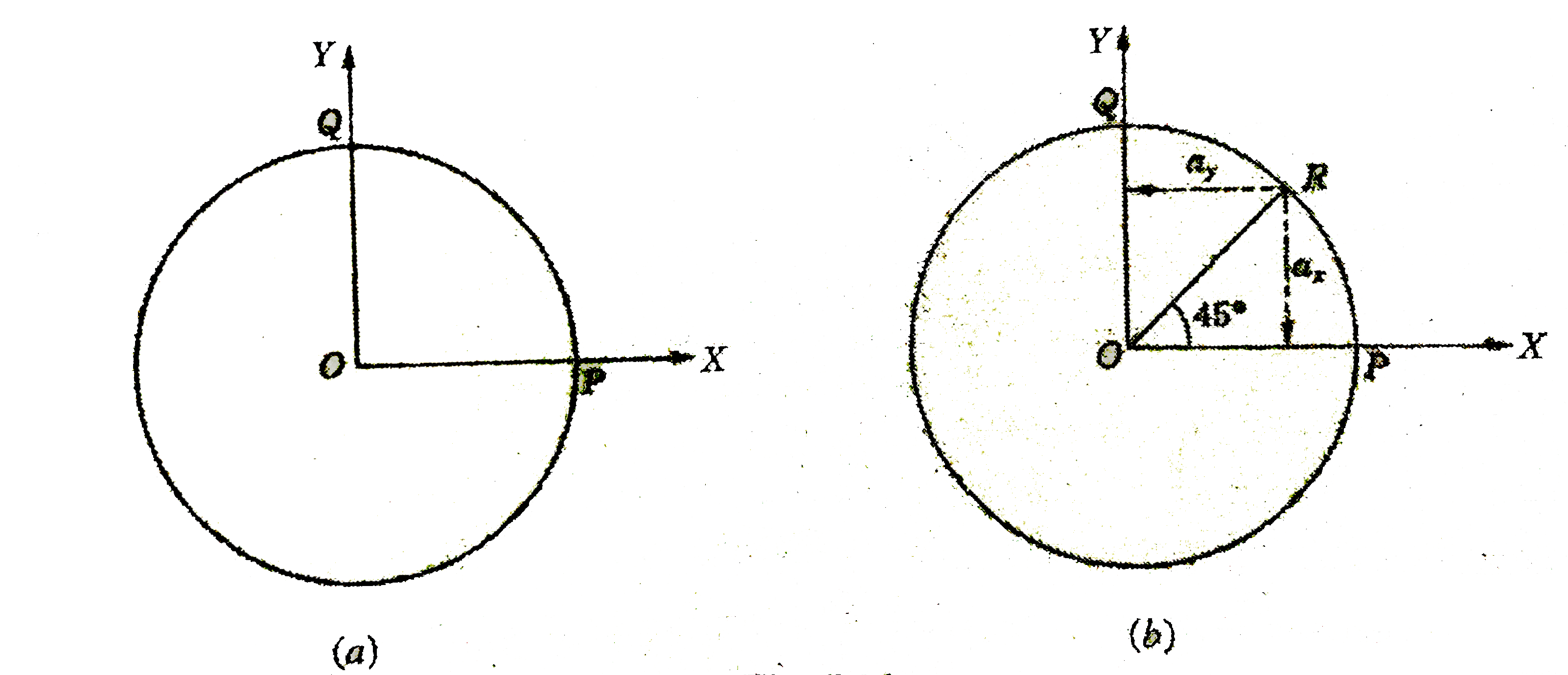 View Solution
View SolutionQuestion 61
A small bead of mass m is carried by a circular hoop having center at O and radius √2m which rotates about a fixed vertical axis. The coefficient of friction between beed and hoop is μ=0.5. The maximum angular speed of the hoop for which the bead does not have relative motion with respect to hoop. (g=10m/s2)
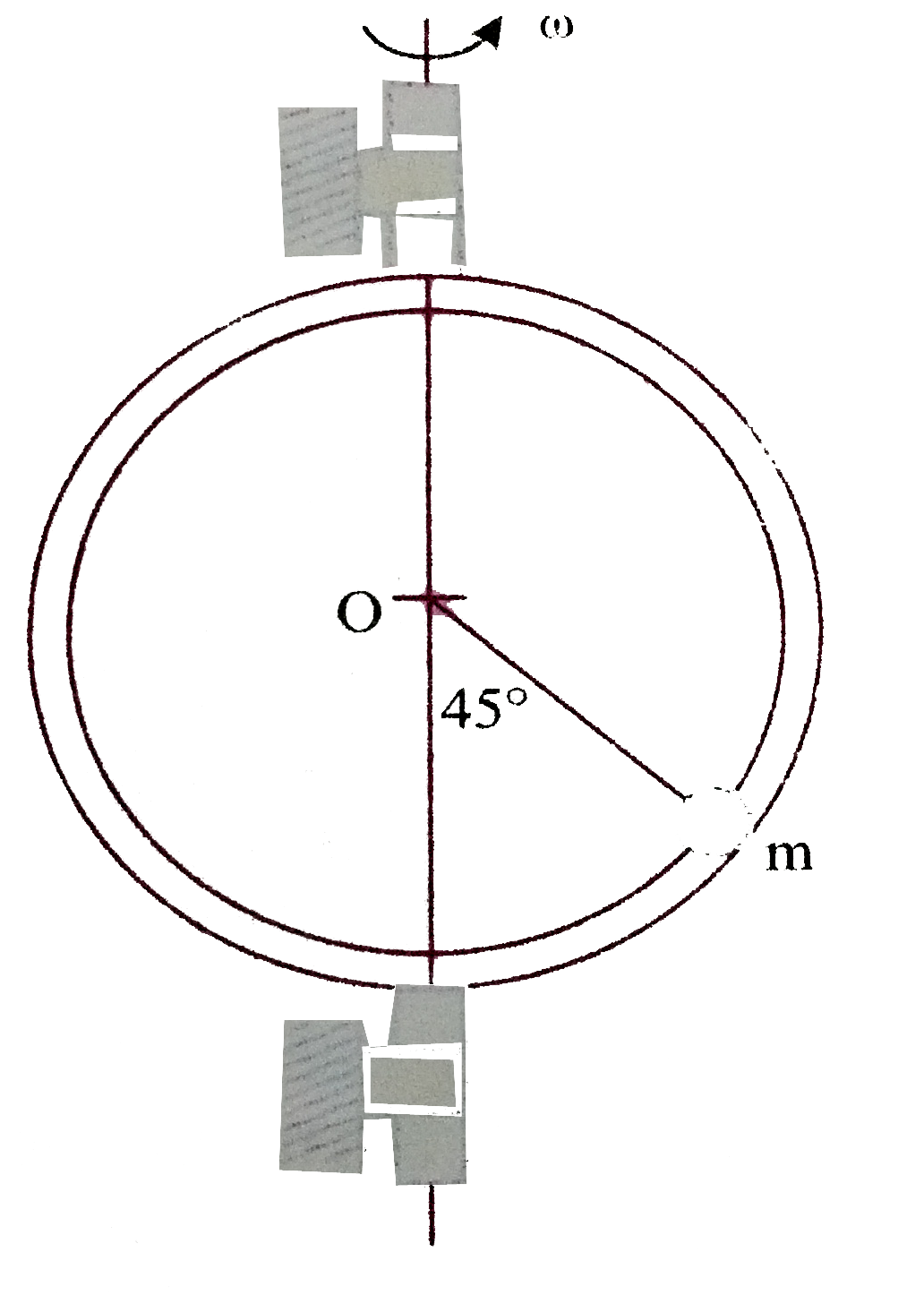 View Solution
View SolutionQuestion 62
Two identical particle are attached at the ends of a light string which passes through a hole at the centre of a table another particle on the table is made to revolve with angular velocity ω1 . One of the particles is made to move in a horizontal circle as a conical pendulum with angular velocity ω2 . If l1 and l2 are the length of the string over and under the table , then in order that particle under the table neither moves down nor moves up the ratio l1l2 is :
 View Solution
View SolutionQuestion 63
For the arrangement in the Figure, the particle M1 attached to one end of string which moves on a horizantal table in a circle of radius l2 (where l is the length of the string) with constant angular speed ω. The other end of the string attached to to mass M2 which rest on a vertical rod. When the rod collapse, the acceleration of mass M2 at that instant
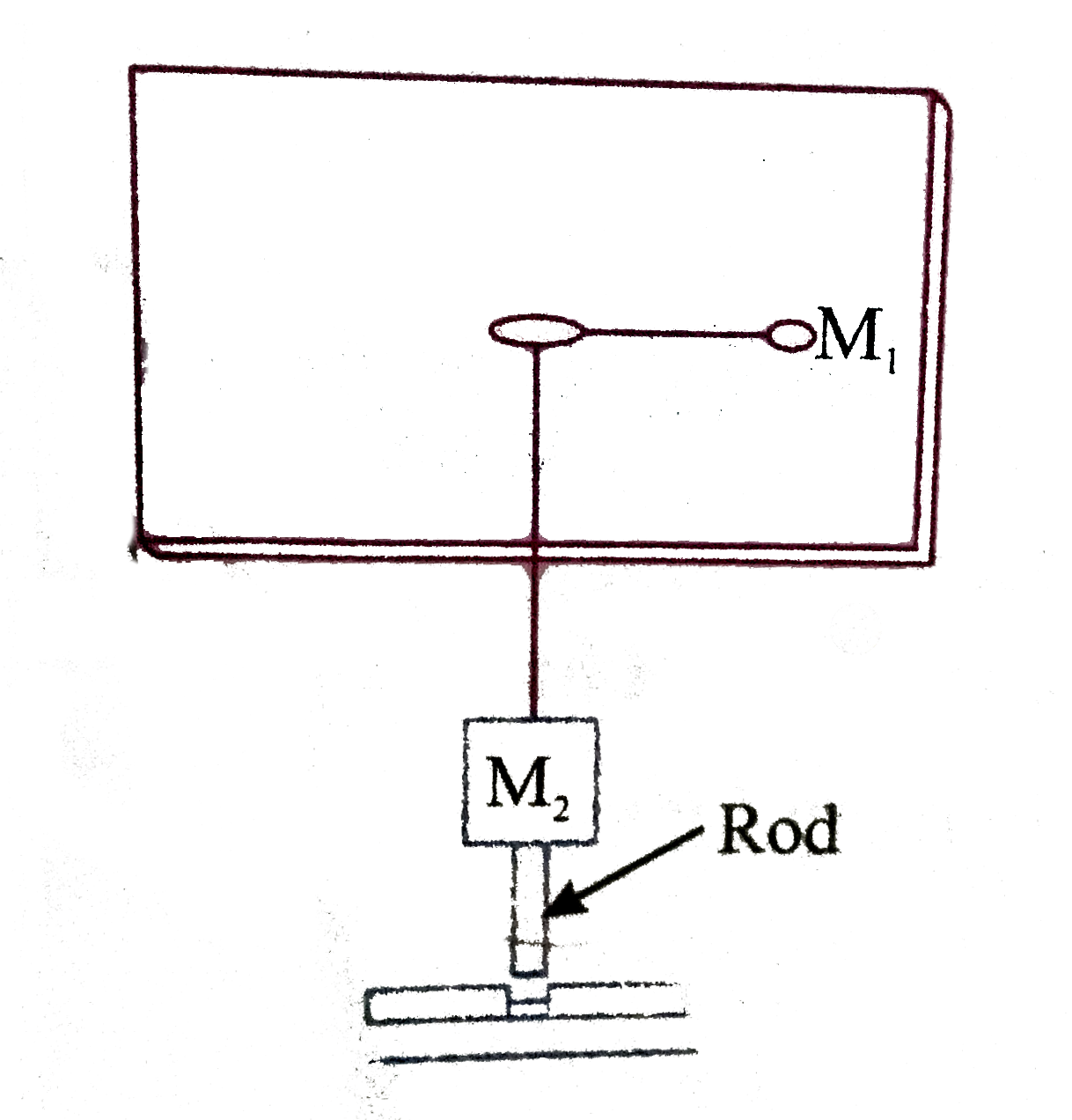 View Solution
View SolutionQuestion 64
A bead of mass m is located on a parabolic wire with its axis vertical and vertex at the origin as shown in figure and whose equations is x2=4ay . The wire frame is fixed and the bead can slide on it without friction . The bead is released from the point y = 4a on the wire frame from rest . The tangential acceleration of the bead when it reaches the position given by y = a is :
 View Solution
View SolutionQuestion 66
A disc of radius R has a light pole fixed perpendicular to the disc at its periphery which in turn has a pendulum of length R attached to its other end as shown in figure. The disc is rotated with a constant angular velocity ω The string is making an angle 45∘ with the rod. Then the angular velocity ω of disc is
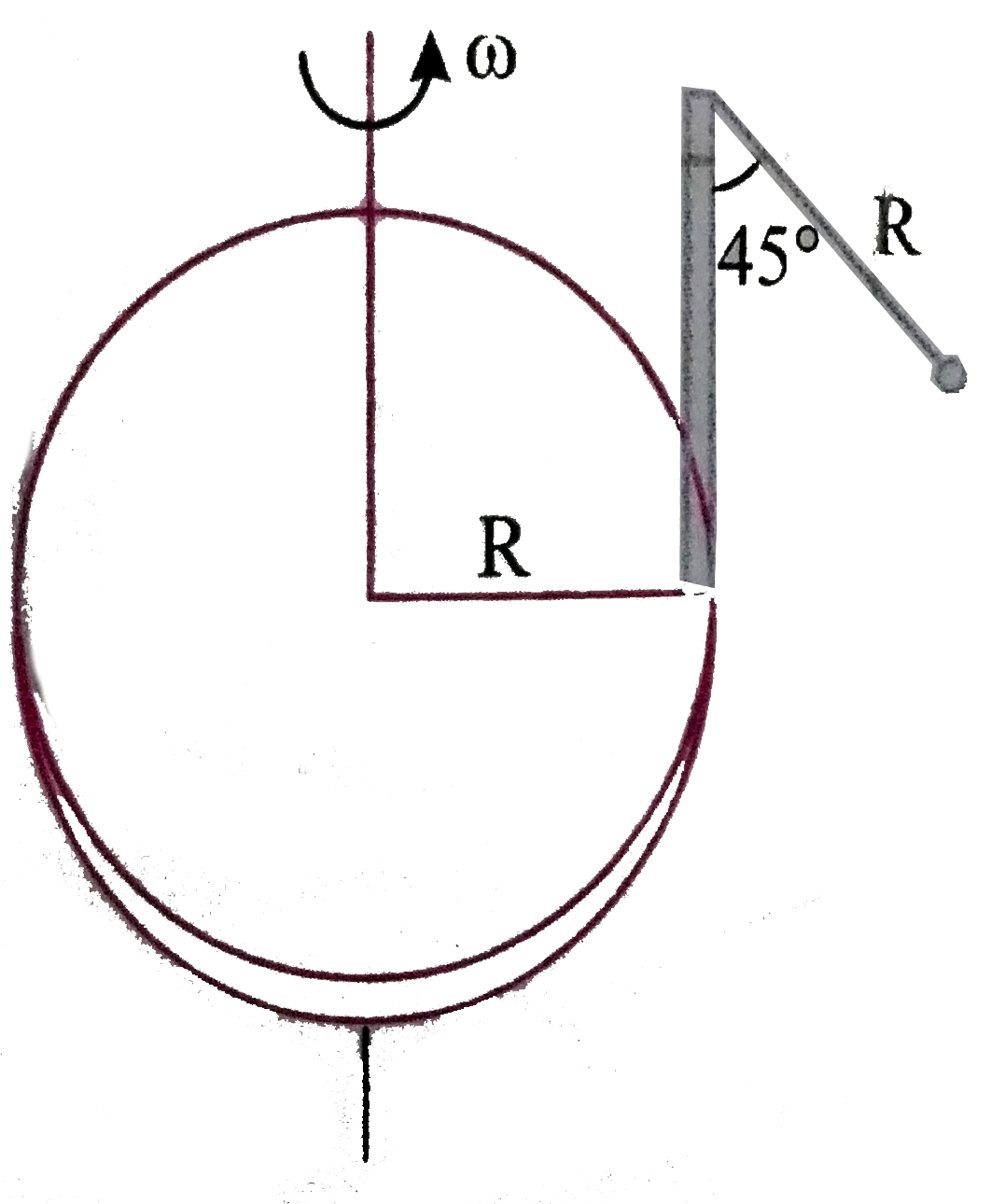 View Solution
View SolutionQuestion 69
A long horizontal rod has a bead which can slide along its length and initially placed at a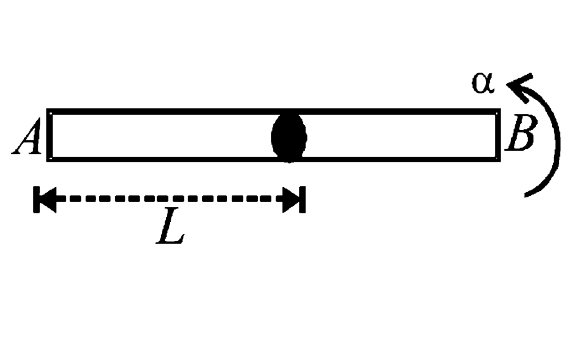
distance L from one end A of the rod. The rod is set in angular motion about A with constant angular acceleration α. if the coefficient of friction between the rod and the bead is μ, and gravity is neglected, then the time after which the bead starts slipping is View SolutionQuestion 74
A block of mass M slides down a rough inclined surface of inclination θ and reaches the bottom at speed at 'v' . However , if it slides down a smooth inclined surface of same length and same inclination , it reaches the bottom with the speed kv. Coefficient of friction between the block and the rough incline is : View SolutionQuestion 78
Two balls of masses m1 and m2 are separated from each other by a powder charge placed between them. The whole system is at rest on the ground. Suddenly the powder charge explodes and masses are pushed apart. The mass m1 travels a distance s1 and stops. If the coefficients of friction between the balls and ground are same, the mass m2 stops after travelling the distance View SolutionQuestion 80
The minimum force required to start pushing a body up a rough (frictional coefficient μ) inclined plane is F1 while the minimum force needed to prevent it from sliding down is F2. If the inclined plane makes an angle θ with the horizontal such that tanθ=2μ then the ratio F1F2 is .View SolutionQuestion 81
A bar of mass m1 is placed on a plank of mass m2 which rests on a smooth horizontal plane . The coefficient of friction between the surfaces of bar and plank is k . The plank is subjected to a horizontal force F depending on time t as F = at , where a is a constant . The moment of time t0 at which the plank starts sliding is :
 View Solution
View SolutionQuestion 82
In the given Fig. 7.154 , two masses 2 kg each are attached to a string which passes over a smooth massless pulley P . The surface PQ is smooth and ∠PQR=45∘ . The surface PR is rough , with coefficient of kinetic friction 1√3 and ∠PRQ=30∘ .The acceleration of the system is :
 View Solution
View SolutionQuestion 83
A block lying on a long horizontal conveyer belt moving at a constant velocity receives a velocity v0=5m/s relative to the ground in the direction opposite to the direction of motion of the conveyer. After t=4s, the velocity of the block becomes equal to the velocity of the belt. The coefficient of friction between the block and the belt is μ=0.2. Determine the velocity v of the conveyer belt. View SolutionQuestion 91
A rectangular block of mass 5 kg is kept on a horizontal surface . The coefficient of friction between the block and the surface is 0.2 . If a force of 20 N is applied to the block at angle of 30∘ with the horizontal plane , what is the force of friction on the block ? (Take g = 10m/s2) View SolutionQuestion 92
In the arrangement shown in figure , there is friction between the blocks of masses m and 2m which are in contact . The ground is smooth . The mass of the suspended block is m . The block of mass m which is kept on mass 2m is stationary with respect to block of mass 2 m . The force of friction between m and 2 m is (pulleys and string are lig frictionless ) :
 View Solution
View SolutionQuestion 93
A block of mass M = 4 kg is kept on a smooth horizontal plane. A bar of mass m = 1 kg is kept on it. They are connected to a spring as shown & the spring is compressed. Then what is the maximum compression in the spring for which the bar will not slip on the block when released if coefficient of friction between them is 0.2 & spring constant = 1000 N/m : (Take g=10m/s2)
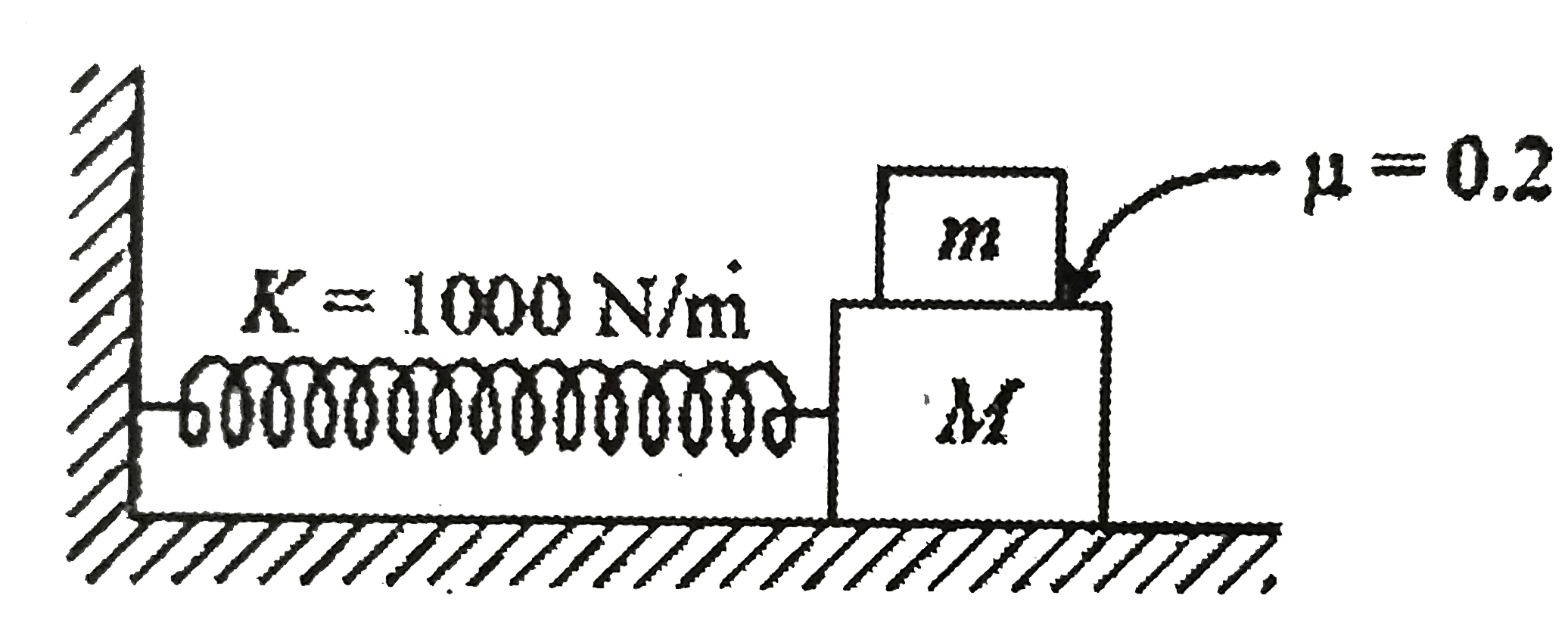 View Solution
View SolutionQuestion 96
A side view of a simplified form of vertical latch B is as shown . The lower member A can be pushed forward in its horizontal channel . The sides of the channels are smooth , but at the interfaces of A and B , which are at 45∘ with the horizontal , there exists a static coefficient of friction μ=0.4 . what is the minimum force F ( in N) that must be applied horizontally to A to start motion of the latch B upwards if it has a mass m = 0.6 kg ?
 View Solution
View SolutionQuestion 98
An insect crawls up a hemispherical surface very slowly (see the figure). The coefficient of friction between the insect and the surface is 1/3. If the line joining the centre of the hemispherical surface to the insect makes an angle α with the vertical, the maximum possible value of α is given by
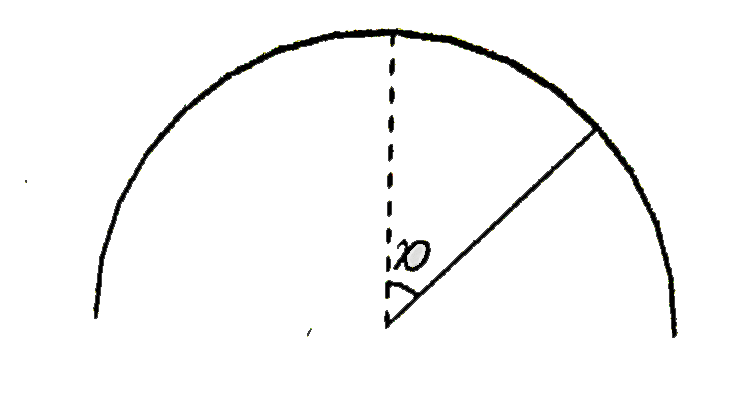 View Solution
View SolutionQuestion 101
A block of mass m is on an inclined plane of angle θ. The coefficient of friction between the block and the plane is μ and tanθ>μ. The block is held stationary by applying a force P parallel to the plane. The direction of force pointing up the plane is taken to be positive. As P is varied from P1=mg(sinθ−μcosθ) to P2=mg(sinθ+μcosθ), the frictional force f versus P graph will look likeView SolutionQuestion 102
A ball of mass (m)0.5kg is attached to the end of a string having length (L)0.5m. The ball is rotated on a horizontal circular path about vertical axis. The maximum tension that the string can bear is 324N. The maximum possible value of angular velocity of ball (in radian//s) is -
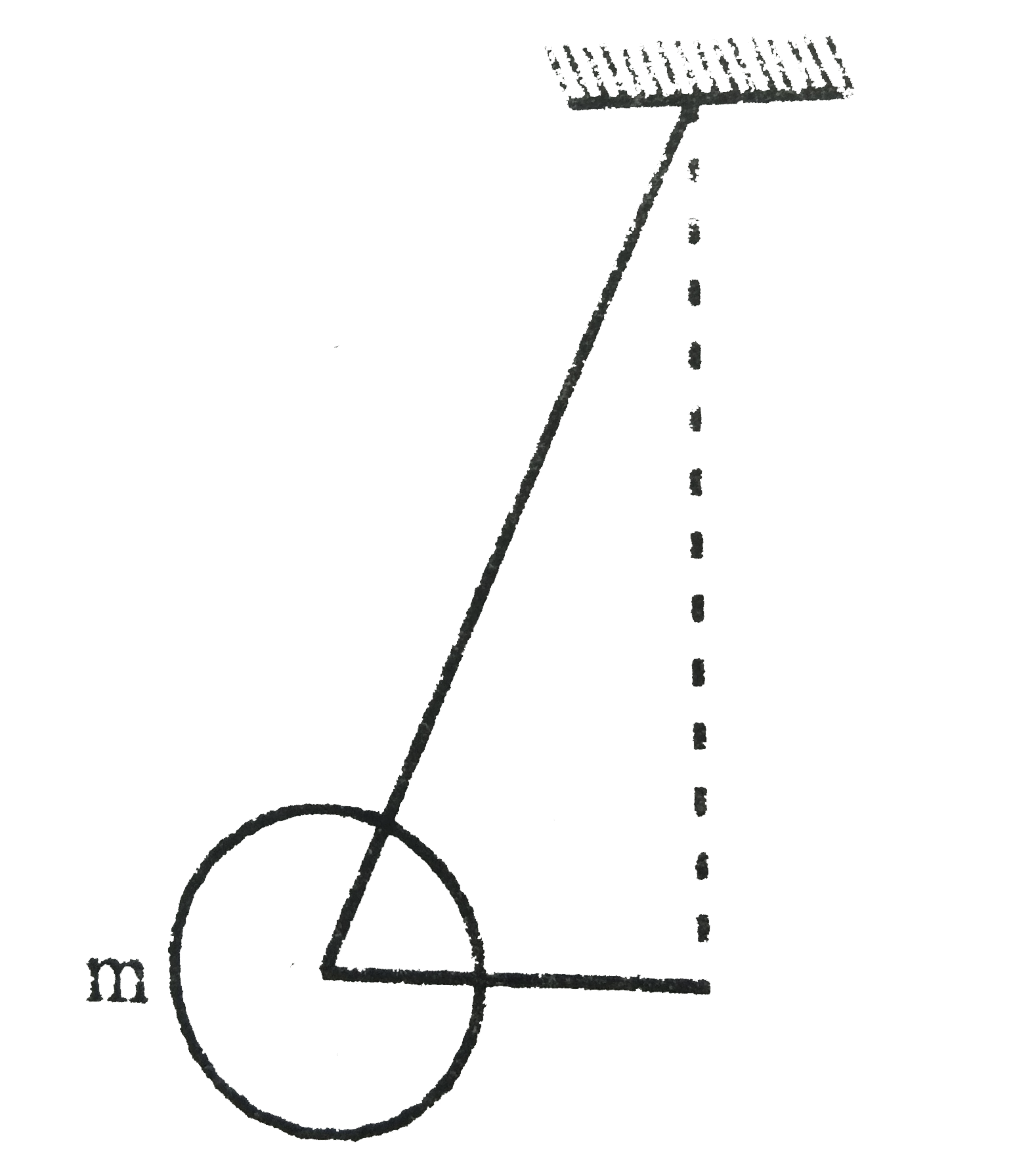 .View Solution
.View SolutionQuestion 103
A block of mass m1 = 1 kg and another mass m2=2 kg are placed together ( see figure) on an inclined plane with angle of inclination θ . Various values of θ are given in List I . The coefficient of friction between the block m1 and the plane is always zero. The coefficient of static and dynamic friction between the block m2 and the plane are equal to μ=0.3 . In List II expressions for the friction on the block m2 are given . Match the correct expression of the friction in List II with the angles given in List I , and choose the option . The acceleration due to gravity is denoted by g .
[Useful information : tan (5.5∘) = 0.1 , tan (11.5∘) = 0.2 , tan (16.5∘)=0.3]
ListIListIIP.θ=5∘1.m2gsinθQ.θ=10∘2.(m1+m2)gsinθR.θ=15∘3.μm2gcosθS.θ=20∘4.μ(m1+m2)gcosθ
 View Solution
View SolutionQuestion 112
As shown in figure AB represents an infinite wall tangential to a horizontal semi circular track.O is a point source of light on the ground at the centre of the circle. A block moves along the circular track with speed v starting from the point where the wall touches the circle. If the velocity and acceleration of shadow along the length of the wall is respectively 'V' and 'a' then,
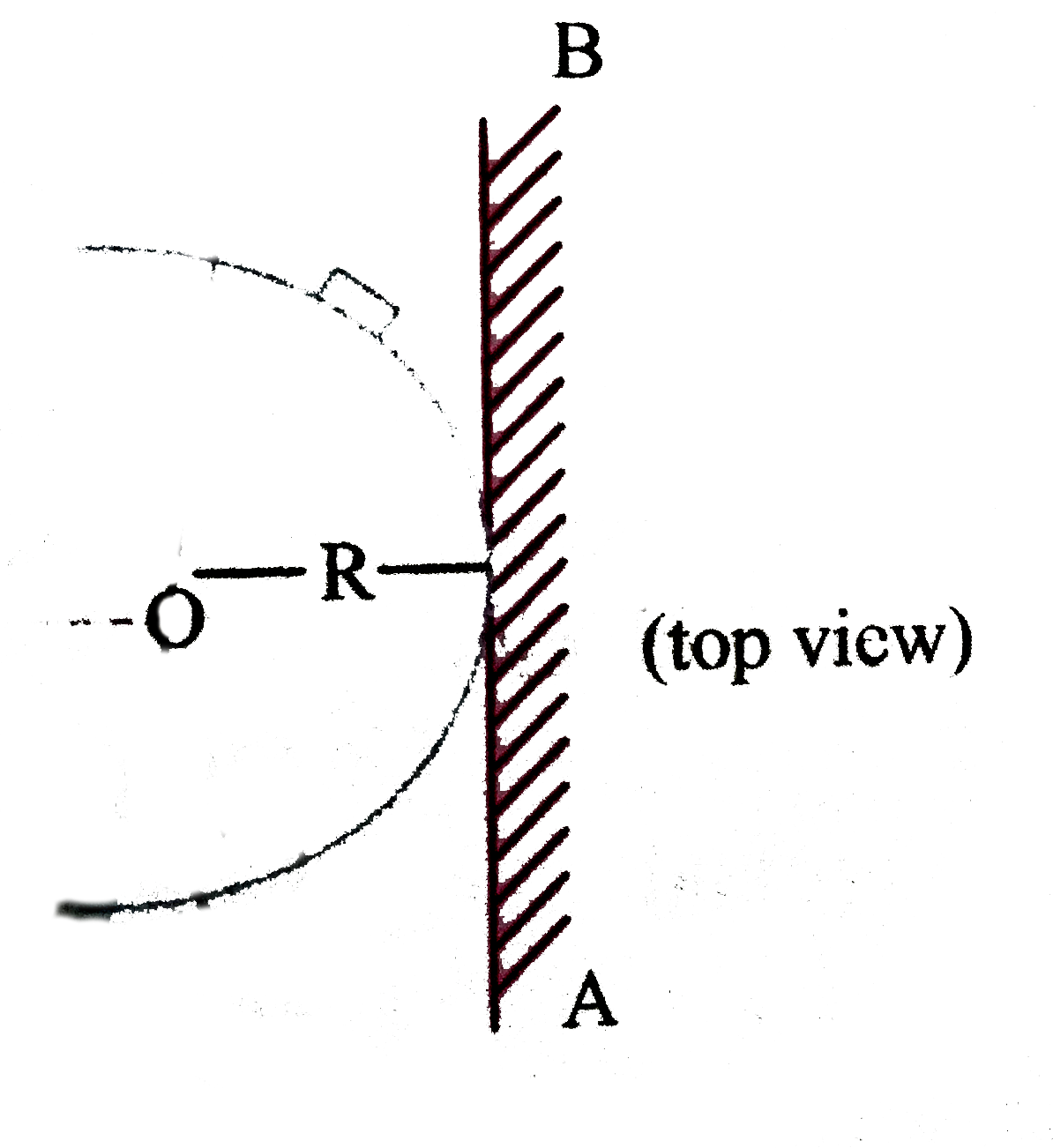 View Solution
View SolutionQuestion 113
ABCDE is a smooth iron track in the vertical plane. The sections ABC and CDE are quarter circles. Points B and D are very close to C.M is a small magnet of mass m. The force of attraction between M and the track is F, which is constant and always normal to the track. M starts from rest at A, then:
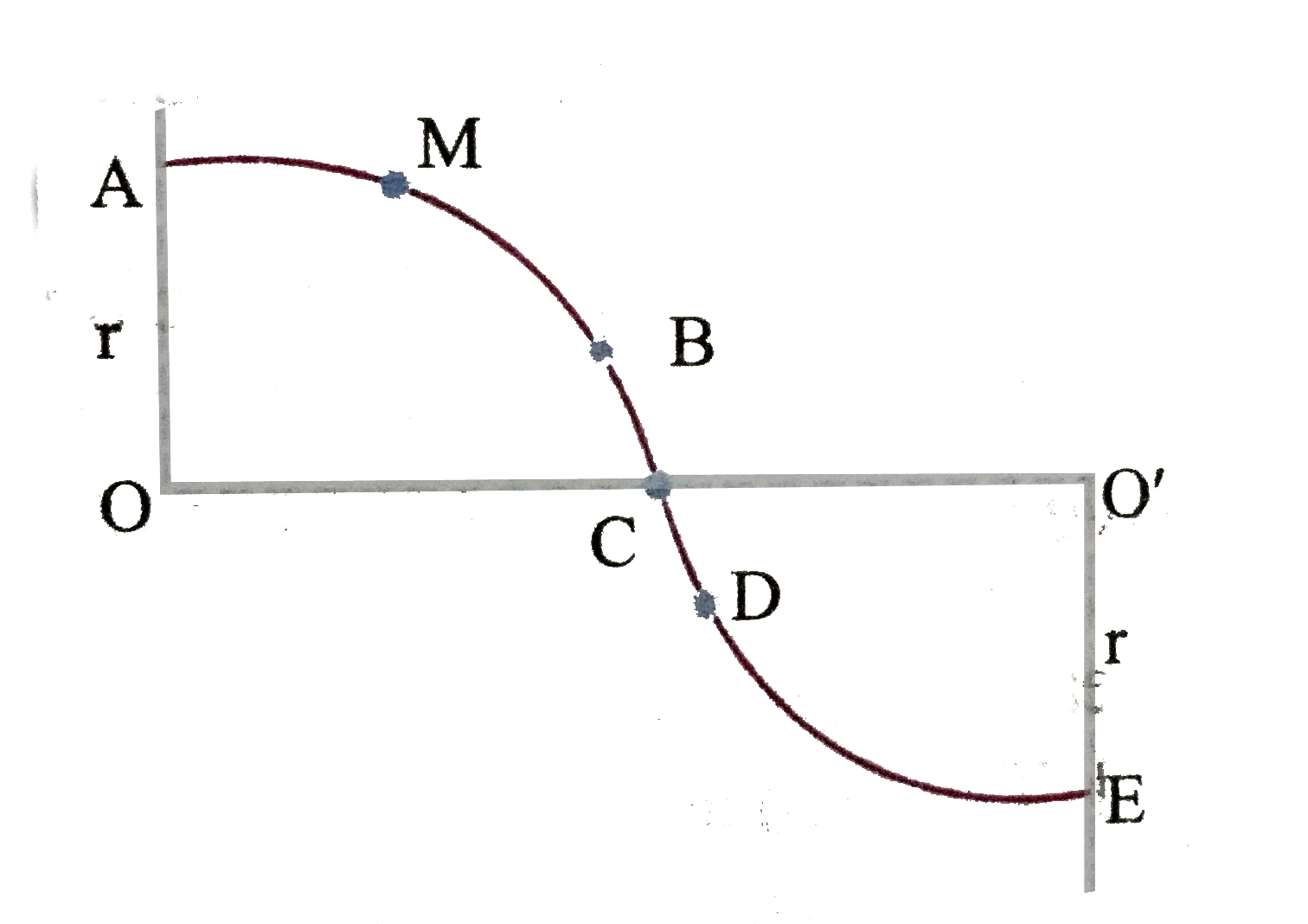 View Solution
View SolutionQuestion 120
A body a of mass m slides on plane inclined at angle θ0 to the horizontal and μ1 is the coefficient of friction between A and the plane A is connected by a light string passing over a frictionless pulley to another body B also of mass m slidding on a frictionless plane inclined at angle θ2 to the horizontal Which of the following statements are ture ?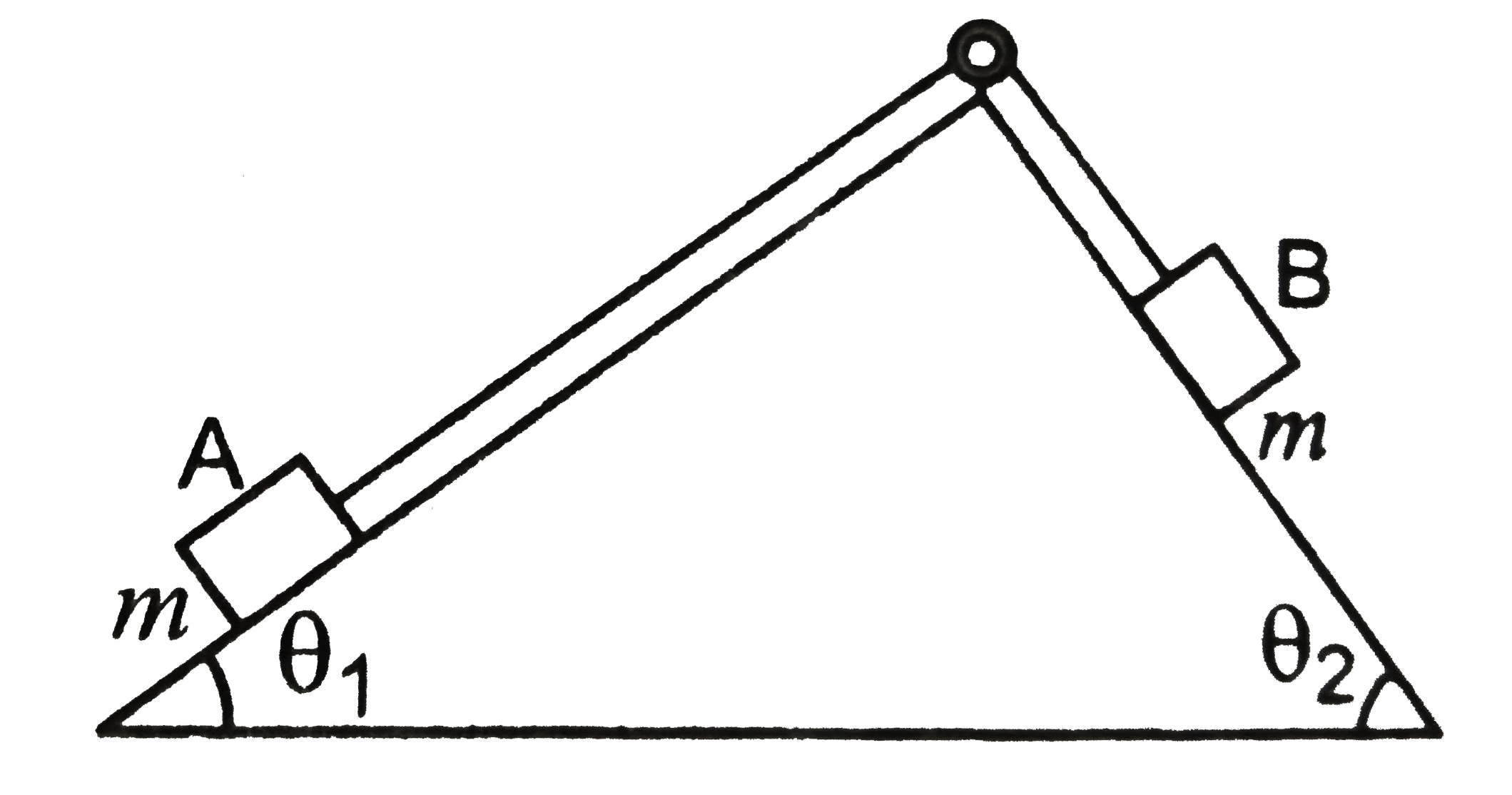 .View Solution
.View SolutionQuestion 123
(A) : In the given Fig . 7 . 184 , a force 20 N pulls a block of mass 10 kg on a rough floor . If coefficient of friction is μ=0.4 , force of friction acting on the block will be 20 N .

(R) : Force of kinetic friction is slightly less than the limiting value of force of friction . View SolutionQuestion 130
(A) : Polishing a surface beyond a certain limit increases rather than decreases the frictional forces .
(R) : When the surface is polished beyond a certain limit , the molecules exert strong attractive force . This is called surface adhesion , to overcome which additional force is required . Hence frictional force increases . View SolutionQuestion 132
Asseration : A block of mass m starts moving on a rough horizontal surface with a velocity v. It stops due to friction between the block and the surface after moving through a ceratin distance. The surface is now tilted to an angle of 30∘ with the horizontal and same block is made to go up on the surface with the same initial velocity v. The decrease in the mechanical energy in the second situation is small than the first situation.
Reason : The coefficient of friction between the block and the surface decreases with the increase in the angle of inclination.View SolutionQuestion 136
Fig. 7. 187 (a) shows a system of two blocks of masses m and M(>m) placed on a surface , there is no friction between the blocks and the surface . A force F is applied to the system as shown resulting in the motion of the system .

Fig. 7.187 (b) also shows a system of blocks of masses m and M . Masses m and M have , respectively , the same values as in Fig . 7.187 (a) . There is no friction between the lower block and the surface on which the system is placed but friction is present at the constant of the two blocks . A force F, having the same value as in Fig. 7.187 (a) , is applied to the lower block resulting in the motion of the system such that both blocks move together with a common acceleration . Match Column-I and II.
 View Solution
View SolutionQuestion 139
Two blocks A and B of mass 2kg and 4kg are placed one over the others as shown in figure. A time vaying horizontal force F=2t is applied on the upper blocks as shown in figure. Here t is in second and F is in newton. Coefficient of friction between A and B is μ=12 and the horizontal surface over which B is placed is smmoth. (g=10m/s2). If acceleration of blocks A as a function of time is given by aA=t/c then find value of c. (t≤7.5s)
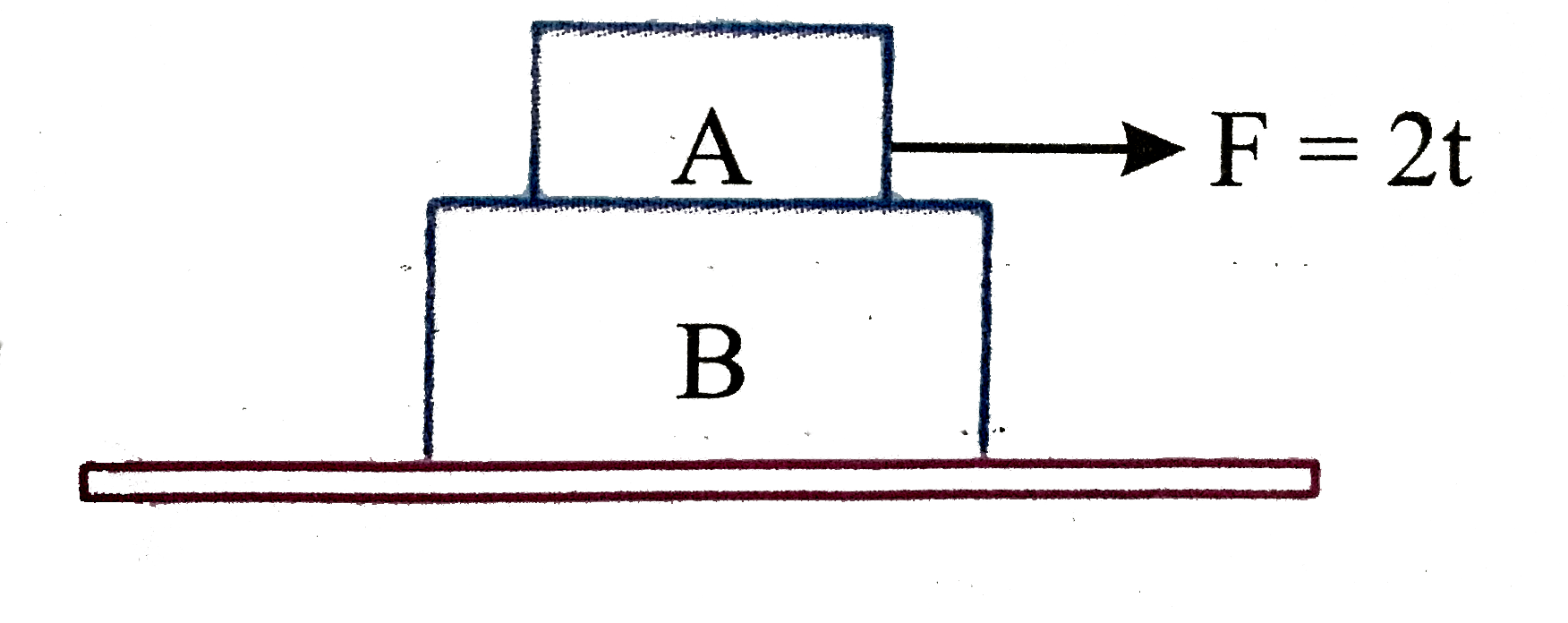 View Solution
View SolutionQuestion 145
A toy car of mass m can travel at a fixed speed. It moves in circle on a fixed horizantal table. A string is connected to the car and attached to a block os mass M that hangs as shown in figure (the portion of string below the table is always vertical). The coefficient of friction between the surface of table and tyres of the toy car is μ. Find the ratio of the maximum radius to the minimum radius for which the toy car can move in a circular path with center O on table. (GivenM=3kg,m=2kg,μ=12)
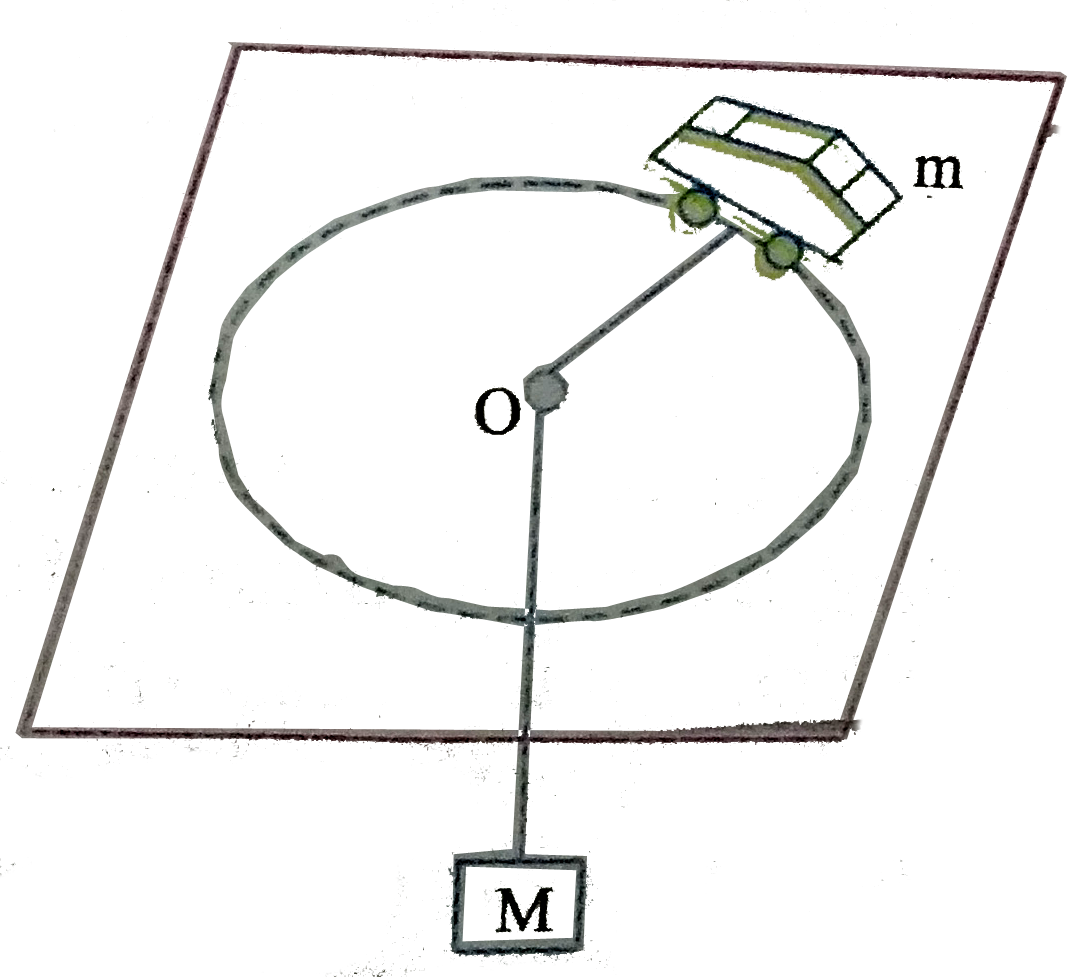 View Solution
View SolutionQuestion 146
A large mass M and a small mass m hang at two ends of a string that passes over a smooth tube as shown in the figure. The mass m moves around a circular path which lies in a horizontal plane. The length of string from the mass m to the top of the tube is l and θ is the 'angle' this length makes with the vertical. What should be the frequency of rotation of mass m, so that the mass M remains stationary?
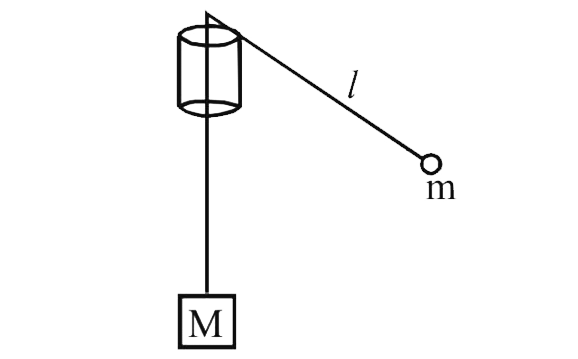 View Solution
View SolutionQuestion 148
A table with smooth horizontal surface is placed in a cabin which moves in a circle of a large radius R = 100 m with ω = 3 rad/s (see figure ) . A smooth pulley of small radius is fastened to the table . Two masses m and 2m placed on the table are connected through a string going over the pulley . initially the masses are held by a person with the strings along the outward radius and then the system is released from rest (with respect to the cabin ) . Then the magnitude of the initial acceleration of the mass m as seen from the cabins is n×100. Find n .
 View Solution
View SolutionQuestion 149
A solid body starts rotating about a stationary axis with an angular acceleration α=(2.0×10−2)trad/s2 here t is in seconds. How soon after the beginning of rotation will the total acceleration vector of an arbitrary point of the body form an angle θ=60∘ with its velocity vector?View SolutionQuestion 150
A 20 kg block is originally at rest on a horizontal surface for which the coefficient of friction is 0.6 . A horizontal force F is applied such that it varies with time as shown in the figure (a) and (b) . If the speed of the block after 10 s is 8 v then find v . (Take g = 10m/s2)
 View Solution
View SolutionQuestion 151
Block A and B are connected by a rod of negligible mass as shown in Fig . 7.199 . The mass of each block is 170 kg . The coefficient of friction between inclined plane and blocks A and B are 0.2 and 0.4 respectively . The tension in the rod is found to be 50 x newtons, the value of x is :
 View Solution
View SolutionQuestion 153
Two blocks A and B of mass 2kg and 4kg are placed one over the others as shown in figure. A time vaying horizontal force F=2t is applied on the upper blocks as shown in figure. Here t is in second and F is in newton. Coefficient of friction between A and B is μ=12 and the horizontal surface over which B is placed is smmoth. (g=10m/s2). If acceleration of blocks A as a function of time is given by aA=t/c then find value of c. (t≤7.5s)
 View Solution
View SolutionQuestion 154
Two blocks of masses M1 and M2 connected by a light spring rest on a horizontal plane . The coefficient of friction between the blocks and the surface is equal to μ . The minimum constant force that has to be applied in the horizontal direction to the block of mass M1 in order to shift the other block is (M1+M2α)μg , then α is : View SolutionQuestion 155
Two blocks A and B of mass 2 kg and 4 kg are placed one over the other as shown in Fig. (a) . A time varying horizontal force F = 2t is applied on the upper block . Here t is in second and F is in newton . A graph drawn between accelerations of A and B on y-axis and time on x-axis is shown in Fig. (b) . Then tan θ=1K , K = .....
 View Solution
View SolutionQuestion 156
A block A of mass 2 kg rests on another block B of mass 8 kg which rests on a horizontal floor . The coefficient of friction between A and B is 0.2 while that between B and floor is 0.5 . When horizontal force F = 25 N is applied on the block B , the force of friction between A and B is (in N) . View SolutionQuestion 158
A block is moving on an inclined plane making an angle 45∘ with the horizontal and the coefficient of friction is μ . The force required to just push it up the inclined plane is 3 times the force required to just prevent it from sliding down . If we define N=10μ , then N is : View SolutionQuestion 162
Two bodies A and B of masses 10 kg and 5 kg are placed very slightly separated as shown in figure . The coefficient of friction between the floor and the blocks are μs=μk=0.4 . Block A is pushed by an external force F . The value of F can be changed . When the welding between block A and ground breaks , block A will start pressing block B and when welding of B also breaks , block B will start pressing the vertical wall .

If F = 20 N , with how much force does block A presses the block B ? View SolutionQuestion 163
Two bodies A and B of masses 10 kg and 5 kg are placed very slightly separated as shown in figure . The coefficient of friction between the floor and the blocks are μs=μk=0.4 . Block A is pushed by an external force F . The value of F can be changed . When the welding between block A and ground breaks , block A will start pressing block B and when welding of B also breaks , block B will start pressing the vertical wall .

If F = 50 N , the friction force acting between block B and ground will be : View SolutionQuestion 164
Two bodies A and B of masses 10 kg and 5 kg are placed very slightly separated as shown in figure . The coefficient of friction between the floor and the blocks are μs=μk=0.4 . Block A is pushed by an external force F . The value of F can be changed . When the welding between block A and ground breaks , block A will start pressing block B and when welding of B also breaks , block B will start pressing the vertical wall .

The force of friction acting on B varies with the applied force F according to curve : View SolutionQuestion 165
A block of mass M slides on a frictionless surface with an initial speed of v0 . On top of block is small box of mass m . The coefficient of friction between box and block are μs and μk . The sliding block encounters an ideal spring with force constant k . Answer the following questions :

Assuming no relative motion between box and block what is the maximum possible acceleration of block and box at the instant of maximum compression ? View SolutionQuestion 166
A block of mass M slides on a frictionless surface with an initial speed of v0 . On top of block is small box of mass m . The coefficient of friction between box and block are μs and μk . The sliding block encounters an ideal spring with force constant k . Answer the following questions :

What is maximum value of k for which it remains true that box does not slide ? View SolutionQuestion 167
A block of mass M slides on a frictionless surface with an initial speed of v0 . On top of block is small box of mass m . The coefficient of friction between box and block are μs and μk . The sliding block encounters an ideal spring with force constant k . Answer the following questions :

Suppose the value of k is just slightly greater than the value found in Q.2 , so that the box begins to slide just as the spring reaches maximum compression . The accelerations of box and block are respectively : View SolutionQuestion 168
A frame of reference that is accelerated with respect to an inertial frame of reference is called a non-inertial frame of reference. A coordinate system fixed on a circular disc rotating about a fixed axis with a constant angular velocity ω is an example of non=inertial frame of reference. The relationship between the force →Frot experienced by a particle of mass m moving on the rotating disc and the force →F∈ experienced by the particle in an inertial frame of reference is
→Frot=→Fin+2m(→vrot×→ω)+m(→ω×→r)×→ω.
where →vrot is the velocity of the particle in the rotating frame of reference and →r is the position vector of the particle with respect to the centre of the disc.
Now consider a smooth slot along a diameter fo a disc of radius R rotating counter-clockwise with a constant angular speed ω about its vertical axis through its center. We assign a coordinate system with the origin at the center of the disc, the x-axis along the slot, the y-axis perpendicular to the slot and the z-axis along the rotation axis (→ω=ωˆk). A small block of mass m is gently placed in the slot at →r(R/2)ˆi at t=0 and is constrained to move only along the slot.
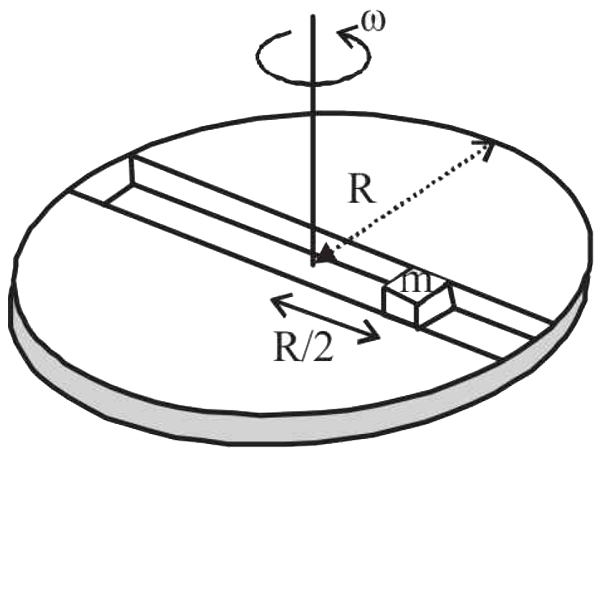
The distance r of the block at time is View SolutionQuestion 169
A frame of reference that is accelerated with respect to an inertial frame of reference is called a non-inertial frame of reference. A coordinate system fixed on a circular disc rotating about a fixed axis with a constant angular velocity ω is an example of non=inertial frame of reference. The relationship between the force →Frot experienced by a particle of mass m moving on the rotating disc and the force →F∈ experienced by the particle in an inertial frame of reference is
→Frot=→Fin+2m(→vrot×→ω)+m(→ω×→r)×→ω.
where →vrot is the velocity of the particle in the rotating frame of reference and →r is the position vector of the particle with respect to the centre of the disc.
Now consider a smooth slot along a diameter fo a disc of radius R rotating counter-clockwise with a constant angular speed ω about its vertical axis through its center. We assign a coordinate system with the origin at the center of the disc, the x-axis along the slot, the y-axis perpendicular to the slot and the z-axis along the rotation axis (→ω=ωˆk). A small block of mass m is gently placed in the slot at →r(R/2)ˆi at t=0 and is constrained to move only along the slot.
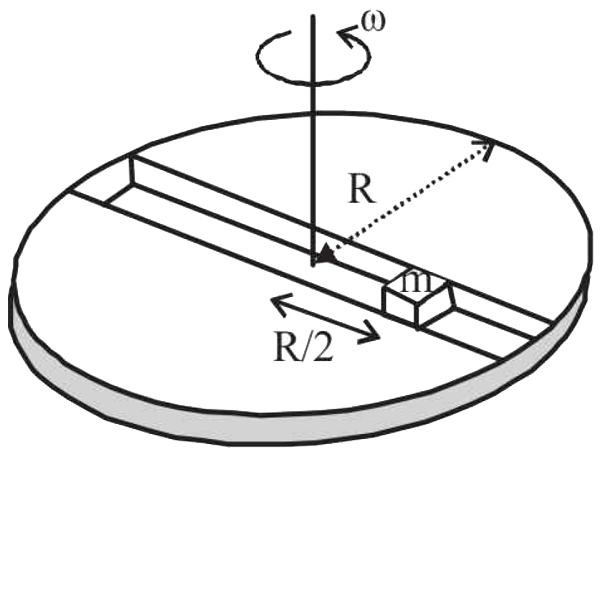
The net reaction of the disc on the block isView Solution

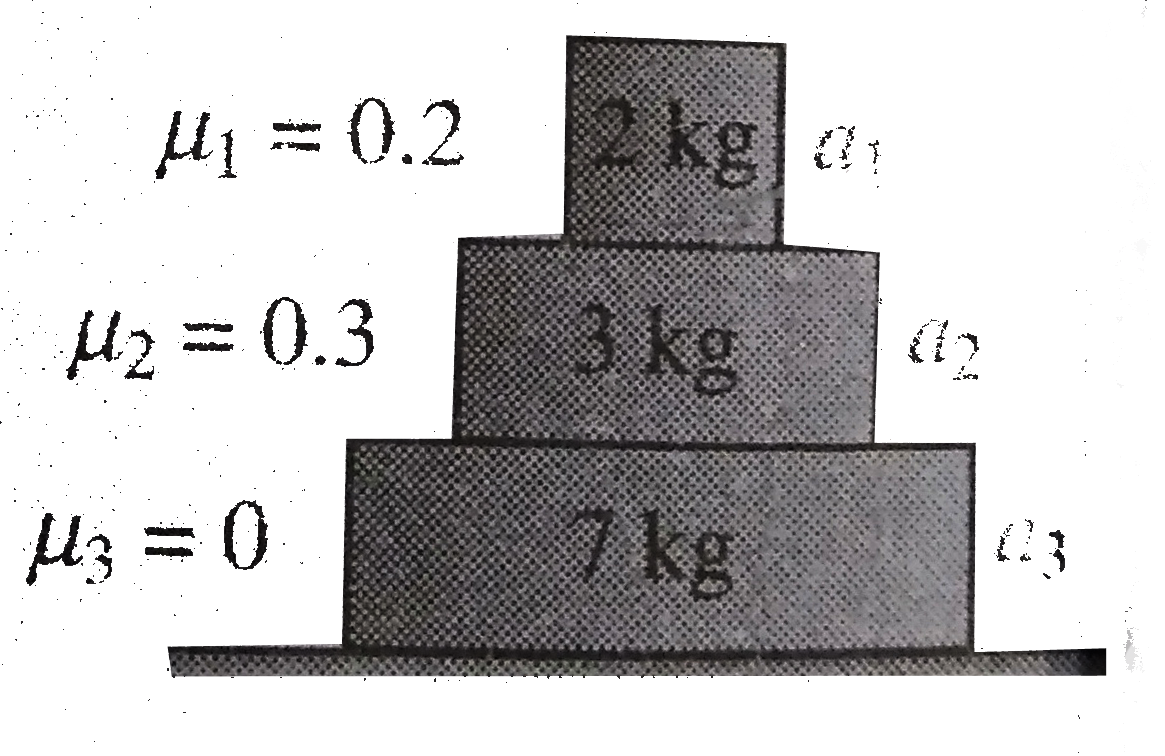
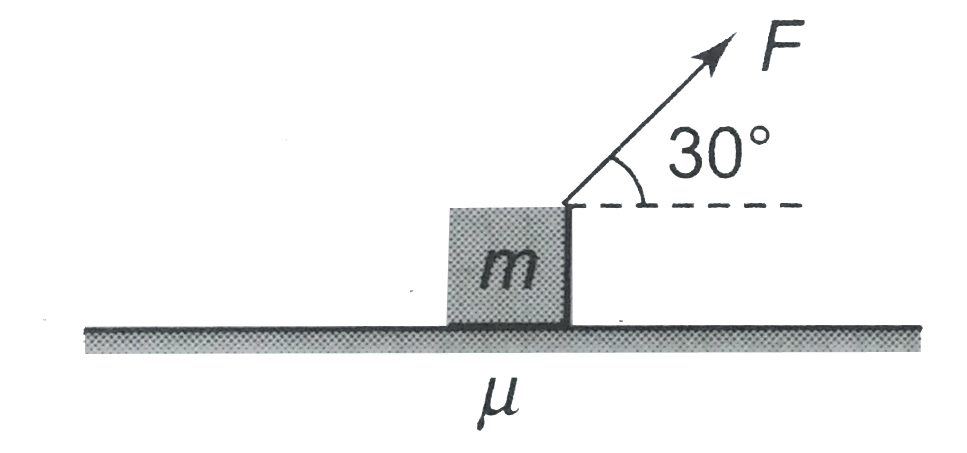






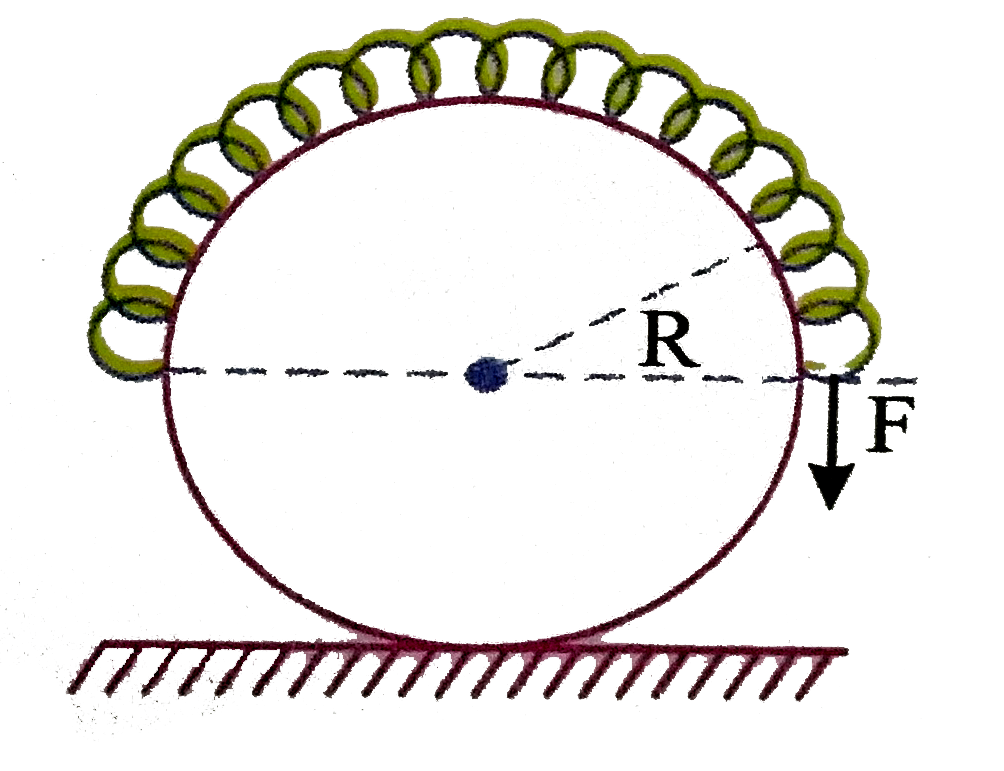
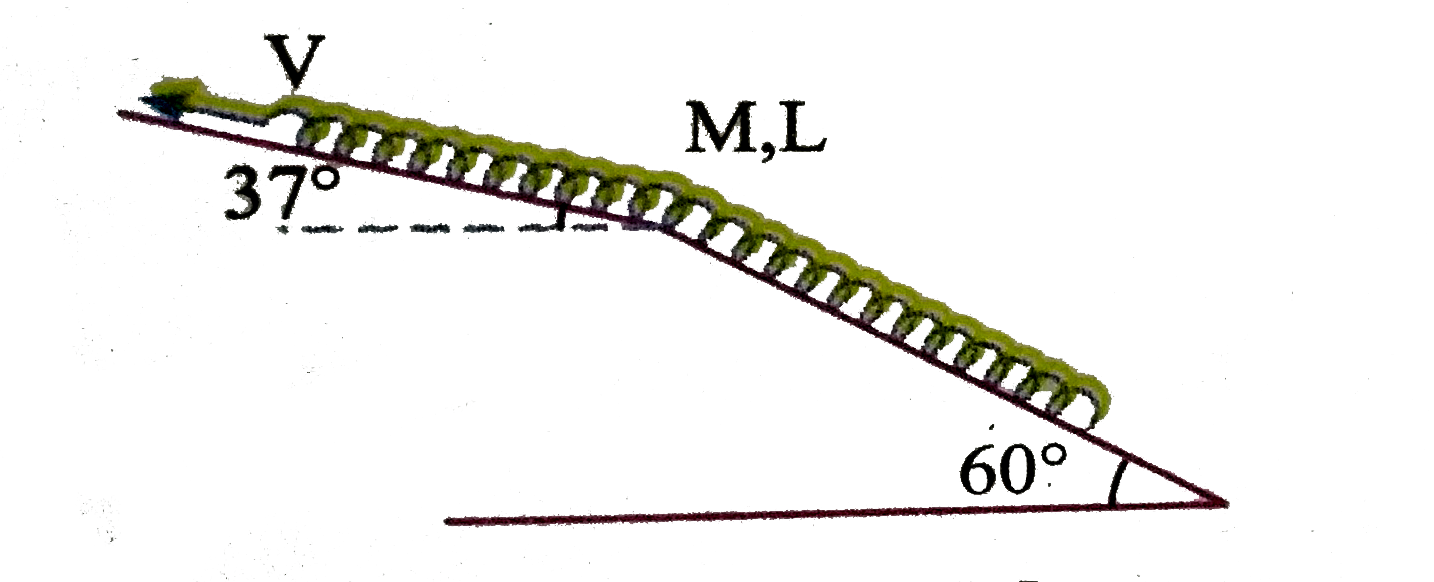

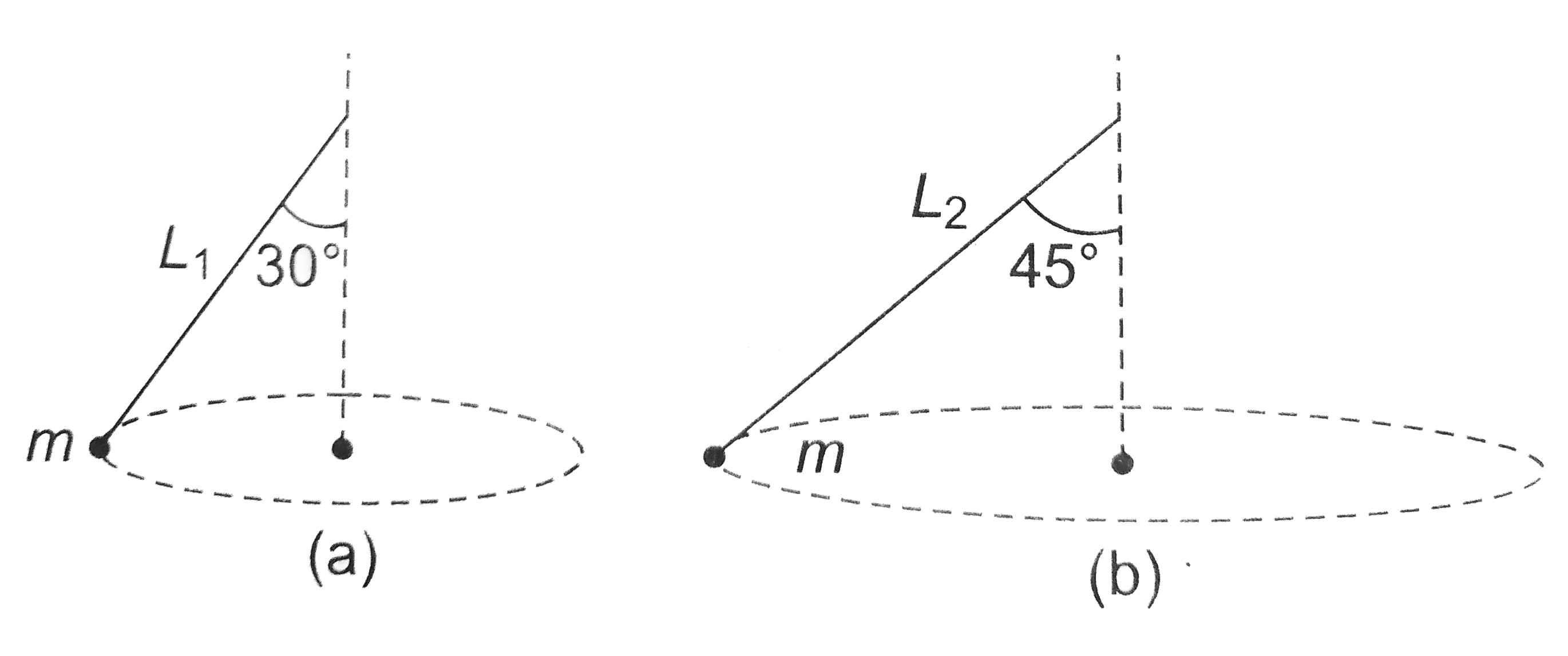

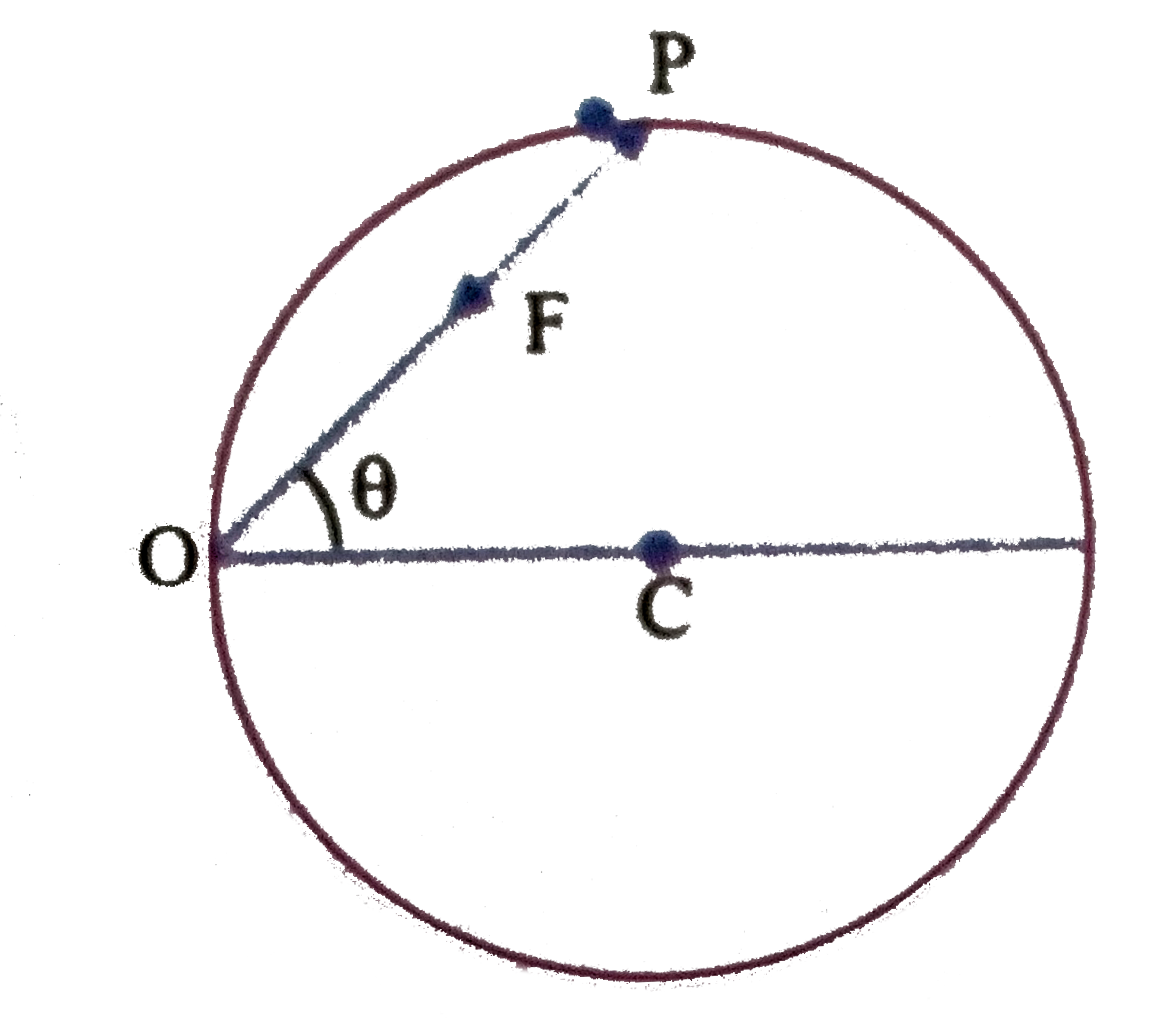












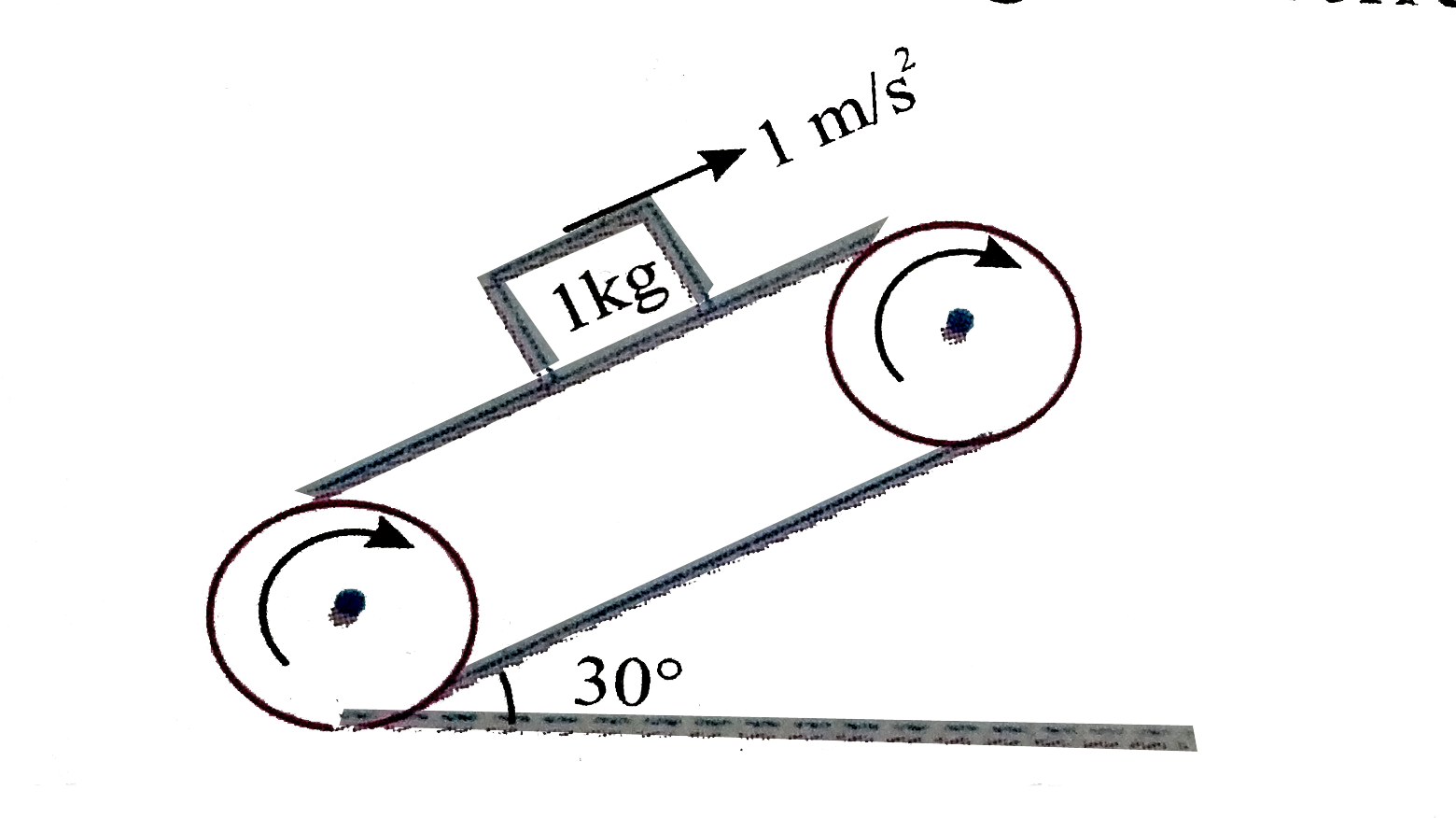
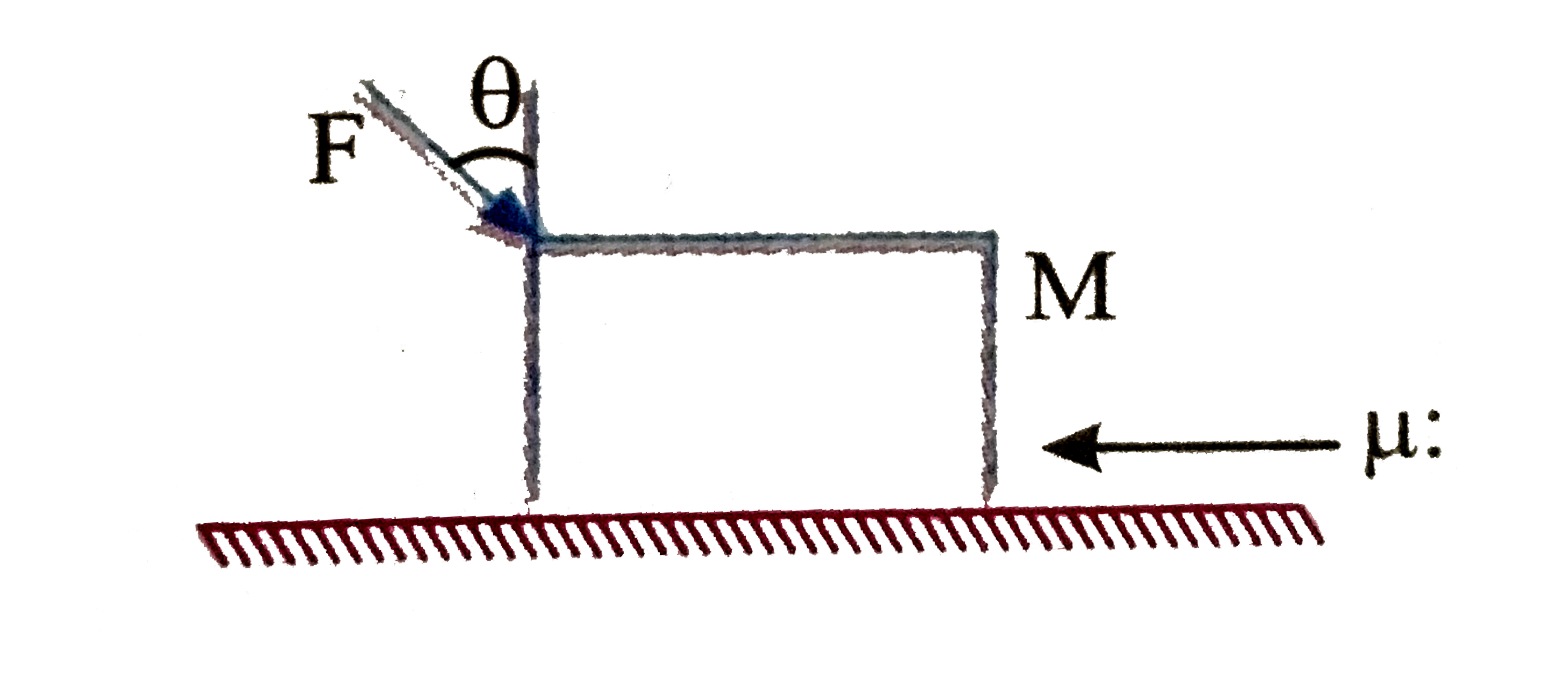
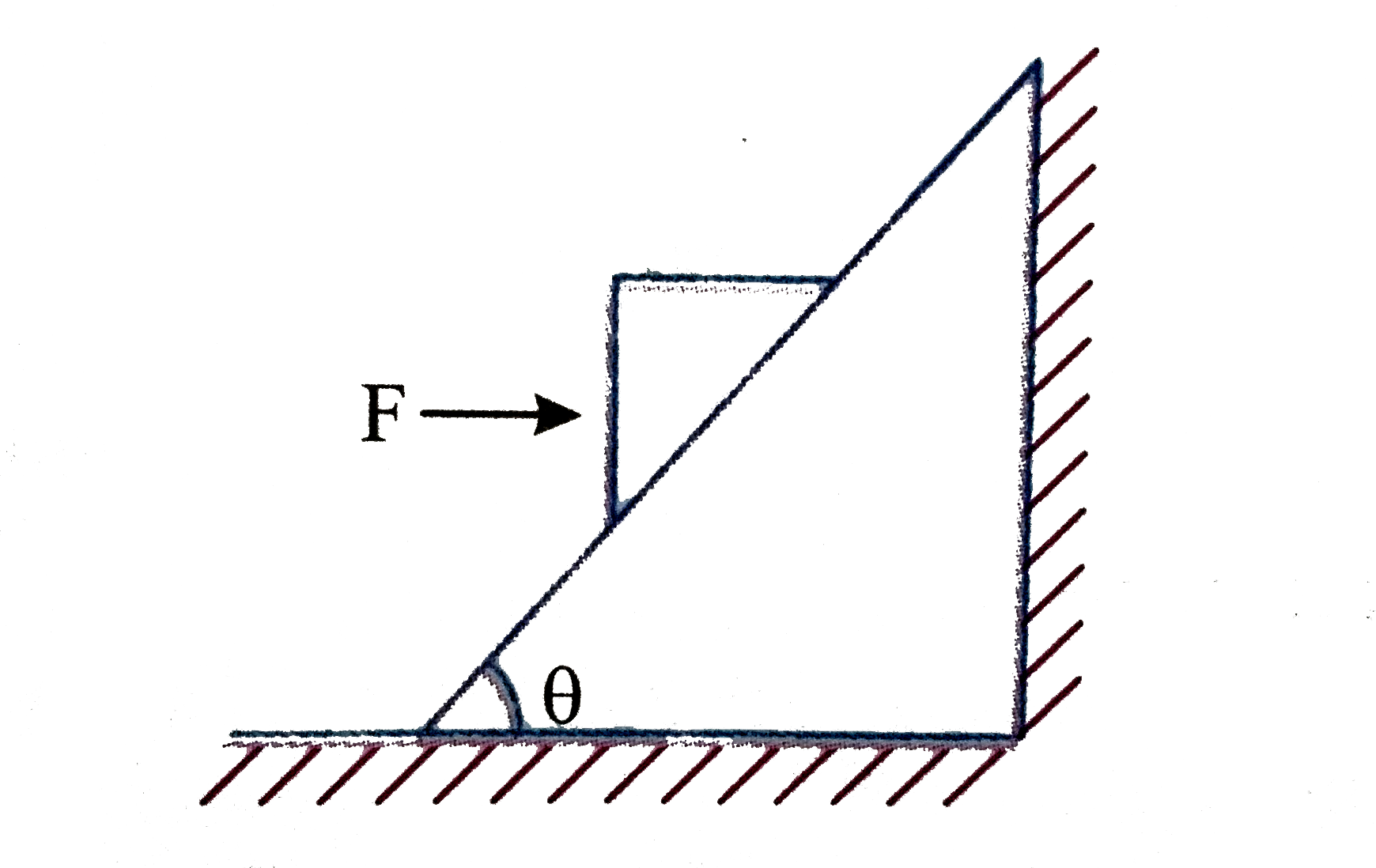

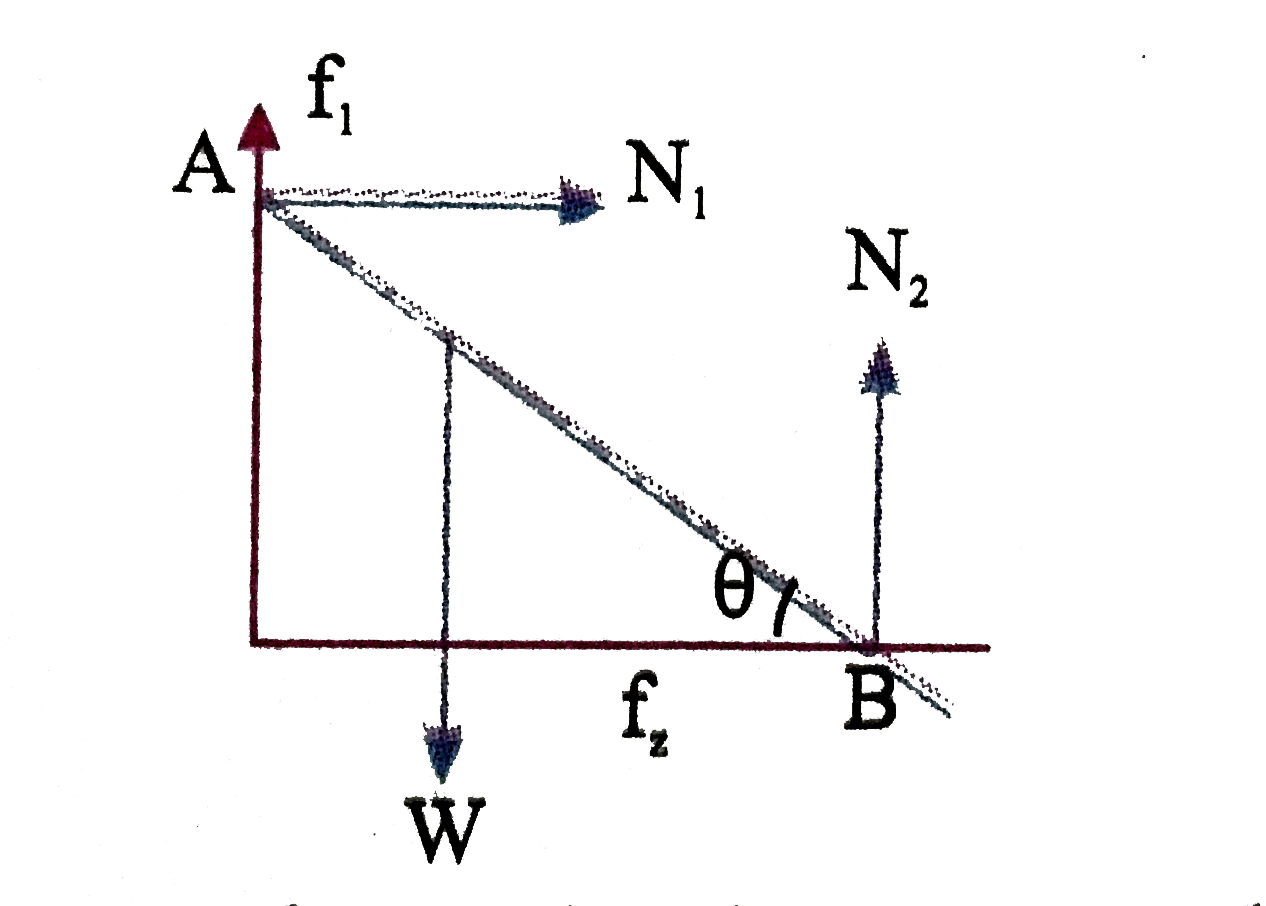
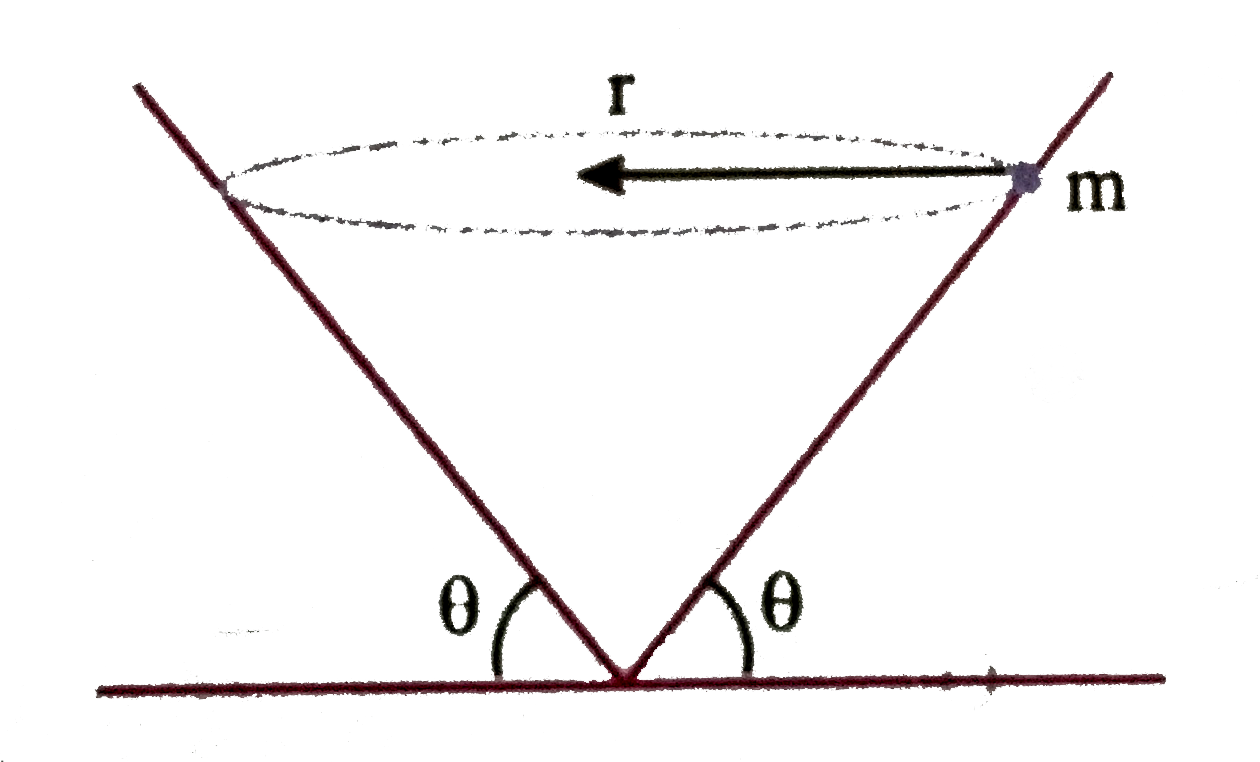
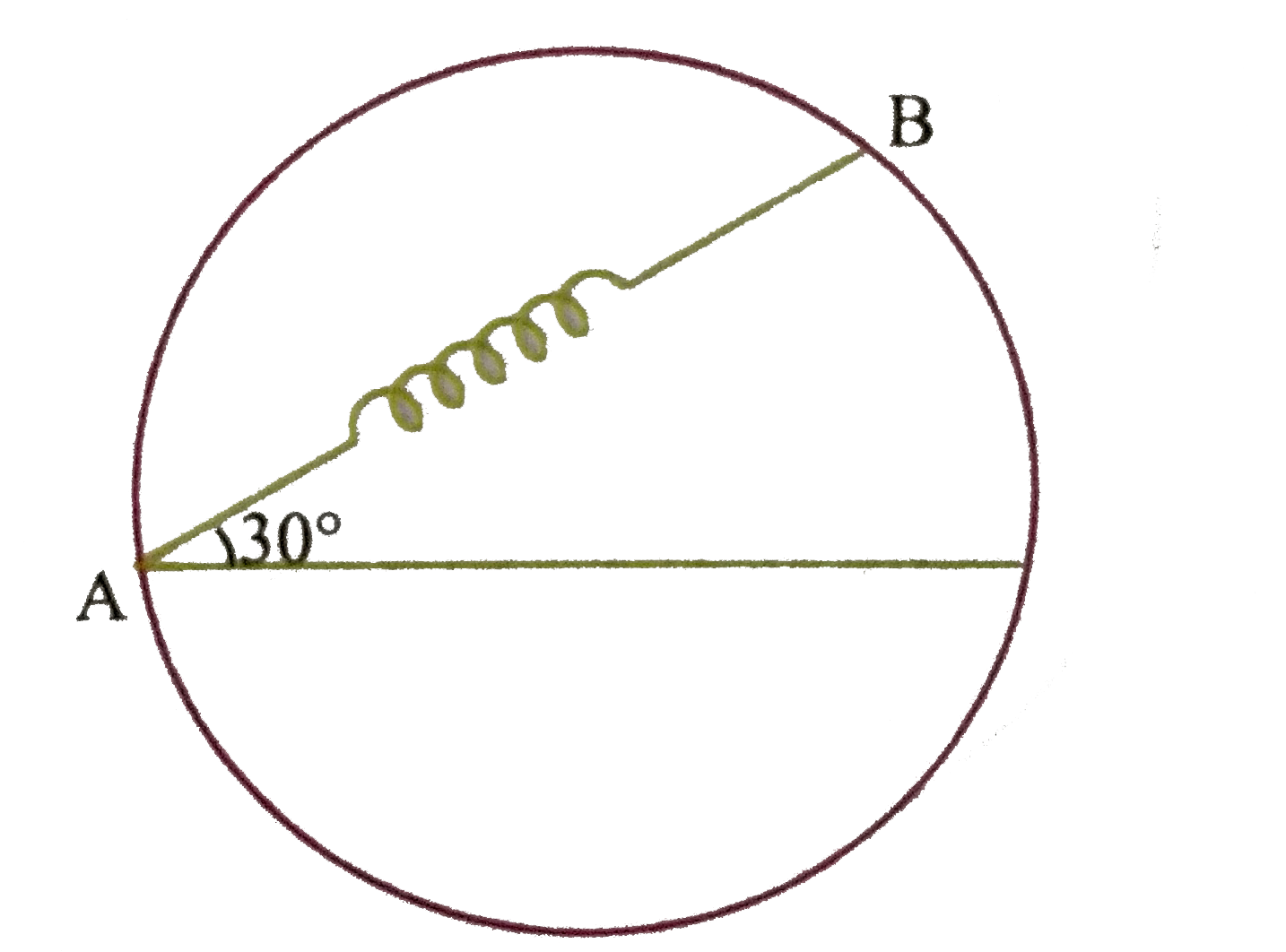

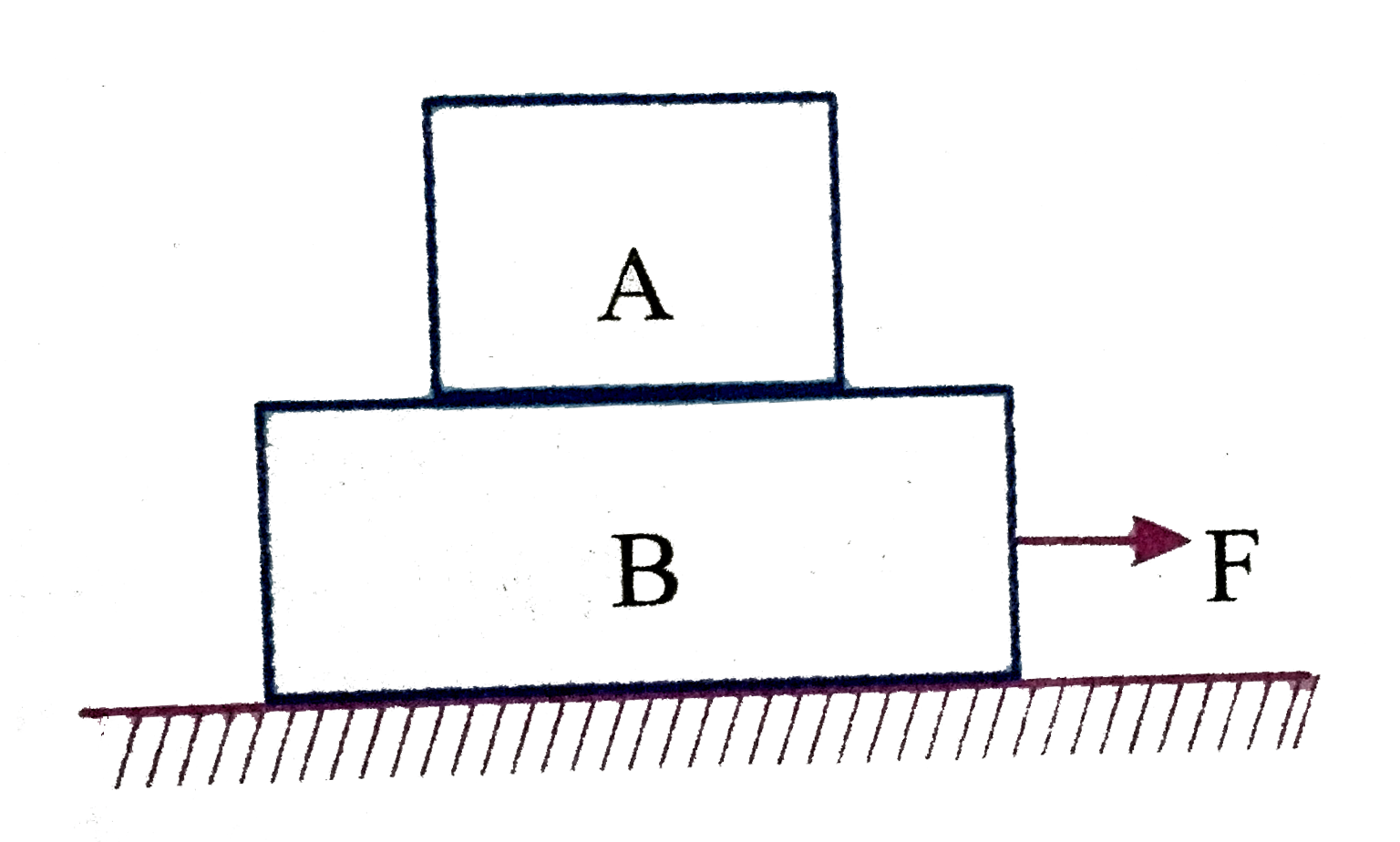 .
.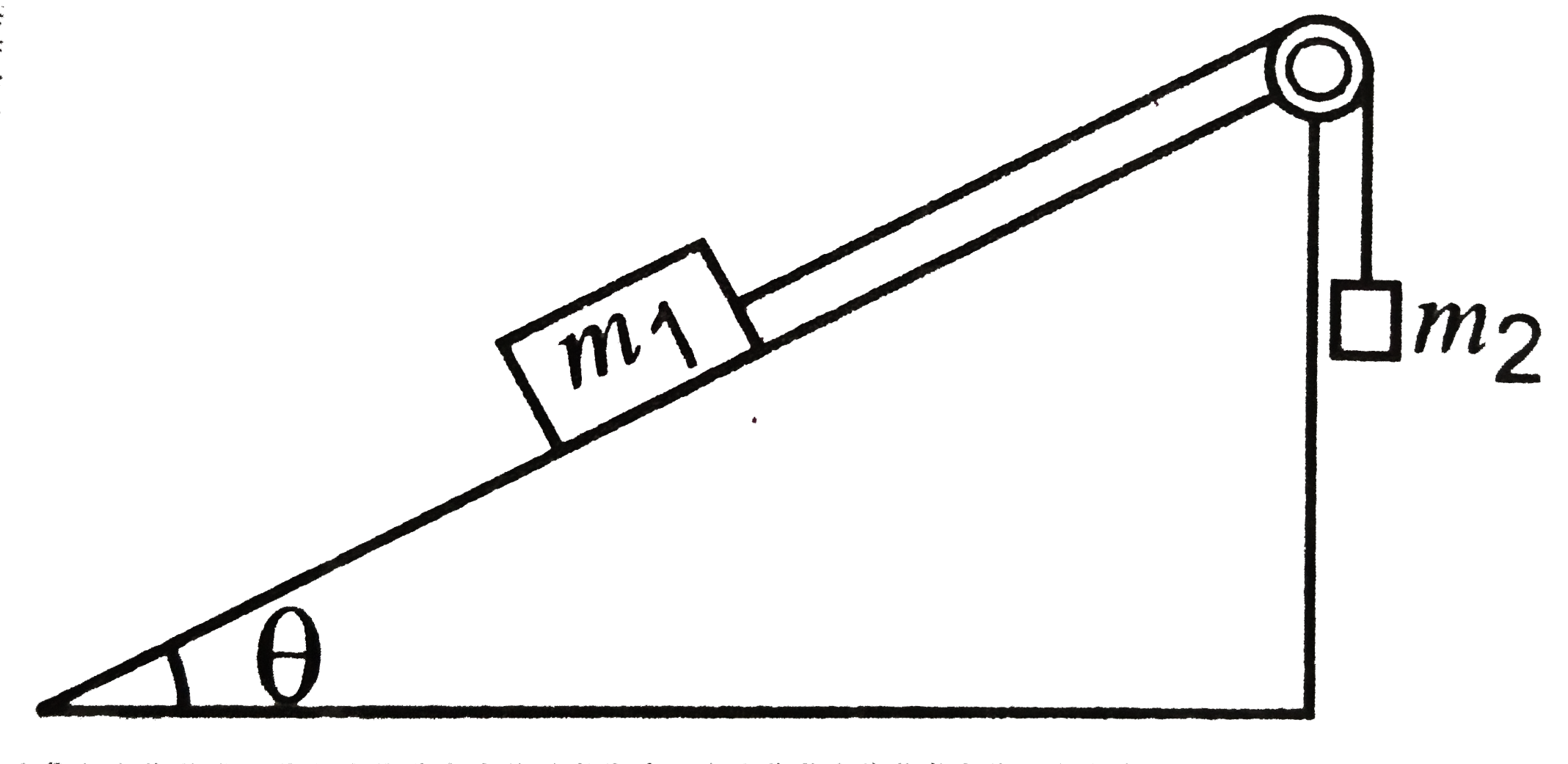 .
.